LG Electronics USA MU50PZ90V 50-inch Plasma Display Monitor User Manual EMISSION TEST REPORT
LG Electronics USA 50-inch Plasma Display Monitor EMISSION TEST REPORT
Users Manual

PLASMA MONITOR
OWNER’S MANUAL
Please read this owner’s manual carefully before operating the
Monitor.
Retain it for future reference.
Record model number and serial number of the Monitor.
See the label attached on the back of the Monitor and quote
this information to your dealer when you require service.
Model number :
Serial number :
MODELS:MU-50PZ90M/90V
MU-50PZ90MA/90VA
MU-50PZ90MB/90VB
MU-50PZ90MK/90VK
MU-50PZ90MR/90VR
MU-50PZ90MS/90VS
P/NO : 3828VA0410A (RF03GB)
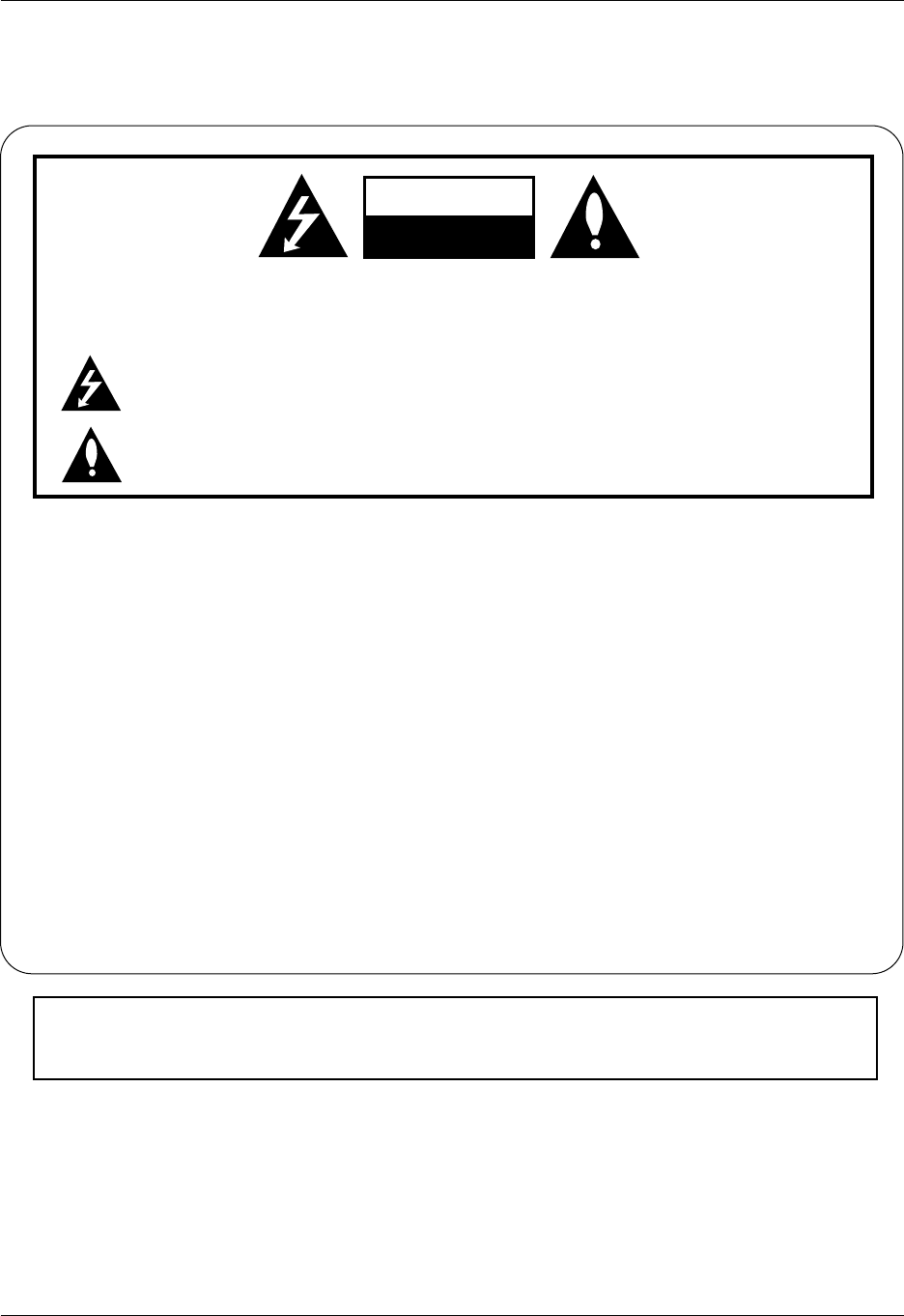
2 Plasma Display
Warning
WARNING:
TO REDUCE THE RISK OF ELECTRIC SHOCK DO NOT REMOVE COVER (OR BACK). NO USER
SERVICEABLE PARTS INSIDE. REFER TO QUALIFIED SERVICE PERSONNEL.
The lightning flash with arrowhead symbol, within an equilateral triangle, is intended to alert the user to
the presence of uninsulated “dangerous voltage” within the product’s enclosure that may be of suffi-
cient magnitude to constitute a risk of electric shock to persons.
The exclamation point within an equilateral triangle is intended to alert the user to the presence of
important operating and maintenance (servicing) instructions in the literature accompanying the appli-
ance.
WARNING:
TO PREVENT FIRE OR SHOCK HAZARDS, DO NOT EXPOSE THIS PRODUCT TO RAIN OR MOISTURE.
FCC NOTICE
• A Class B digital device
This equipment has been tested and found to comply with the limits for a Class B digital device, pursuant to Part
15 of the FCC Rules. These limits are designed to provide reasonable protection against harmful interference in
a residential installation. This equipment generates, uses and can radiate radio frequency energy and, if not
installed and used in accordance with the instructions, may cause harmful interference to radio communications.
However, there is no guarantee that interference will not occur in a particular installation. If this equipment does
cause harmful interference to radio or television reception, which can be determined by turning the equipment off
and on, the user is encouraged to try to correct the interference by one or more of the following measures:
- Reorient or relocate the receiving antenna.
- Increase the separation between the equipment and receiver.
- Connect the equipment into an outlet on a circuit different from that to which the receiver is connected.
- Consult the dealer or an experienced radio/TV technician for help.
• Any changes or modifications not expressly approved by the party responsible for compli-
ance could void the user’s authority to operate the equipment.
WARNING
RISK OF ELECTRIC SHOCK
DO NOT OPEN
WARNING
TO REDUCE THE RISK OF FIRE AND ELECTRIC SHOCK, DO NOT EXPOSE THIS PRODUCT TO
RAIN OR MOISTURE.
W
Warning
arning

Owner’s Manual 3
Safety Instruction
Important safeguards for you and your new product
Your product has been manufactured and tested with your safety in mind. However, improper use can result in potential elec-
trical shock or fire hazards. To avoid defeating the safeguards that have been built into your new product, please read and
observe the following safety points when installing and using your new product, and save them for future reference.
Observing the simple precautions discussed in this booklet can help you get many years of enjoyment and safe operation
that are built into your new product.
This product complies with all applicable U.S. Federal safety requirements, and those of the Canadian Standards
Association.
1. Read Instructions
All the safety and operating instructions should be read
before the product is operated.
2. Follow Instructions
All operating and use instructions should be followed.
3. Retain Instructions
The safety and operating instructions should be retained for
future reference.
4. Heed Warnings
All warnings on the product and in the operating instructions
should be adhered to.
5. Cleaning
Unplug this product from the wall outlet before cleaning. Do
not use liquid cleaners or aerosol cleaners. Use a damp
cloth for cleaning.
6. Water and Moisture
Do not use this product near water, for example, near a bath
tub, wash bowl, kitchen sink, or laundry tub, in a wet base-
ment, or near a swimming pool.
7. Accessories Carts and Stands
Do not place this product on a slippery or tilted surface, or on
an unstable cart, stand, tripod, bracket, or table. The product
may slide or fall, causing serious injury to a child or adult,
and serious damage to the product. Use only with a cart,
stand, tripod, bracket, or table recommended by the manu-
facturer, or sold with the product. Any mounting of the prod-
uct should follow the manufacturer’s instructions, and should
use a mounting accessory recommended by the manufac-
turer.
8. Transporting Product
A product and cart combination should be moved with care.
Quick stops, excessive force, and uneven surfaces may
cause the product and cart combination to overturn.
9. Attachments
Do not use attachments not recommended by the product
manufacturer as they may cause hazards.
10. Ventilation
Slots and openings in the cabinet are provided for ventilation
and to ensure reliable operation of the product and to protect
it from overheating, and these openings must not be blocked
or covered. The openings should never be blocked by plac-
ing the product on a bed, sofa, rug, or other similar surface.
This product should not be placed in a built-in installation
such as a bookcase or rack unless proper ventilation is pro-
vided or the manufacturer’s instructions have been adhered
to.
11. Power Sources
This product should be operated only from the type of power
source indicated on the marking label. If you are not sure of
the type of power supply to your home, consult your product
dealer or local power company. For products intended to
operate from battery power, or other sources, refer to the
operating instructions.
12. Power-Cord Polarization
This product is equipped with a three-wire grounding type
plug, a plug having a third (grounding) pin. This plug will only
fit into the grounding-type power outlet. This is a safety fea-
ture. If you are unable to insert the plug into the outlet, con-
tact your electrician to replace your obsolete outlet. Do not
defeat the safety purpose of the grounding-type plug.
13. Power-Cord Protection
Power-supply cords should be routed so that they are not
likely to be walked on or pinched by items placed upon or
against them, paying particular attention to cords at plugs,
convenience receptacles, and the point where they exit from
the product.
PORTABLE CART WARNING
(Continued on next page)
Safety Instructions
Safety Instructions

4 Plasma Display
Safety Instruction
Antenna Lead in Wire
Antenna Discharge Unit
(NEC Section 810-20)
Grounding Conductor
(NEC Section 810-21)
Ground Clamps
Power Service Grounding
Electrode System (NEC
Art 250, Part H)
Ground Clamp
Electric Service
Equipment
Example of Grounding According to National
Electrical Code Instructions
NEC - National Electrical Code
14. Outdoor Antenna Grounding
If an outside antenna or cable system is connected to the
product, be sure the antenna or cable system is grounded so
as to provide some protection against voltage surges and
built-up static charges. Article 810 of the National Electrical
Code (U.S.A.), ANSI/ NFPA 70 provides information with
regard to proper grounding of the mast and supporting struc-
ture, grounding of the lead-in wire to an antenna discharge
unit, size of grounding conductors, location of antenna-dis-
charge unit, connection to grounding electrodes, and
requirements for the grounding electrode.
15. Lightning
For added protection for this product (receiver) during a light-
ning storm, or when it is left unattended and unused for long
periods of time, unplug it from the wall outlet and disconnect
the antenna or cable system. This will prevent damage to the
product due to lightning and power-line surges.
16. Power Lines
An outside antenna system should not be located in the
vicinity of overhead power lines or other electric light or
power circuits, or where it can fall into such power lines or
circuits. When installing an outside antenna system, extreme
care should be taken to keep from touching such power lines
or circuits as contact with them might be fatal.
17. Overloading
Do not overload wall outlets and extension cords as this can
result in a risk of fire or electric shock.
18. Object and Liquid Entry
Never push objects of any kind into this product through
openings as they may touch dangerous voltage points or
short-out parts that could result in a fire or electric shock.
Never spill liquid of any kind on the product.
19. Servicing
Do not attempt to service this product yourself as opening or
removing covers may expose you to dangerous voltage or
other hazards. Refer all servicing to qualified service per-
sonnel.
20. Damage Requiring Service
Unplug this product from the wall outlet and refer servicing to
qualified service personnel under the following conditions:
a. If the power-supply cord or plug is damaged.
b. If liquid has been spilled, or objects have fallen into the
product.
c. If the product has been exposed to rain or water.
d. If the product does not operate normally by following the
operating instructions. Adjust only those controls that are
covered by the operating instructions as an improper
adjustment of other controls may result in damage and
will often require extensive work by a qualified technician
to restore the product to its normal operation.
e. If the product has been dropped or the cabinet has been
damaged.
f. If the product exhibits a distinct change in performance.
21. Replacement Parts
When replacement parts are required, be sure the service
technician has used replacement parts specified by the man-
ufacturer or have the same characteristics as the original
part. Unauthorized substitutions may result in fire, electric
shock, or other hazards.
22. Safety Check
Upon completion of any service or repairs to this product,
ask the service technician to perform safety checks to deter-
mine that the product is in proper operating condition.
23. Wall or Ceiling Mounting
The product should be mounted to a wall or ceiling only as
recommended by the manufacturer. The product may slide
or fall, causing serious injury to a child or adult, and serious
damage to the product.
24. Heat
The product should be situated away from heat sources
such as radiators, heat registers, stoves, or other products
(including amplifiers) that produce heat.
(Continued from previous page)
Safety Instructions continued
Safety Instructions continued

Owner’s Manual 5
Contents
After reading this manual, keep it handy for future reference.
Warnings . . . . . . . . . . . . . . . . . . . . . . . . . . . . . . . . . . . . .2
Safety Instructions . . . . . . . . . . . . . . . . . . . . . . . . . . . . .3~4
Introduction
Controls and Connection Options . . . . . . . . . . . .7
Remote Control Key Functions . . . . . . . . . . . . . .8
Installation
Installation Instruction . . . . . . . . . . . . . . . . . . . .9~10
External Equipment Connections . . . . . . . . . .11~14
VCR Setup . . . . . . . . . . . . . . . . . . . . . . . . . . . .11
Cable TV Setup . . . . . . . . . . . . . . . . . . . . . . . .11
External A/V Source Setup . . . . . . . . . . . . . . . .12
DVD Setup . . . . . . . . . . . . . . . . . . . . . . . . . . . .12
DTV Setup . . . . . . . . . . . . . . . . . . . . . . . . . . . .12
PC Setup . . . . . . . . . . . . . . . . . . . . . . . . . .13~14
Operation
Turning on the Monitor . . . . . . . . . . . . . . . . . . . . .15
Menu Language Selection . . . . . . . . . . . . . . . . . .15
Video Menu Options
APC (Auto Picture Control) . . . . . . . . . . . . . . . .16
Manual Picture Control . . . . . . . . . . . . . . . . . . .16
Adjusting Auto Color Control . . . . . . . . . . . . . . .16
Manual Color Temperature Control . . . . . . . . . .16
Audio Menu Options
DASP (Digital Auto Sound Processing) . . . . . . .17
Manual Sound Control . . . . . . . . . . . . . . . . . . .17
AVL (Auto Volume Leveler) . . . . . . . . . . . . . . . .17
Time Menu Options
Setting the Clock . . . . . . . . . . . . . . . . . . . . . . .18
Setting the On/Off Timer . . . . . . . . . . . . . . . . .18
Auto Off . . . . . . . . . . . . . . . . . . . . . . . . . . . . . .18
Sleep Timer . . . . . . . . . . . . . . . . . . . . . . . . . . .18
Special Menu Options
Key Lock . . . . . . . . . . . . . . . . . . . . . . . . . . . . .19
ISM Method . . . . . . . . . . . . . . . . . . . . . . . . . . .19
Low power . . . . . . . . . . . . . . . . . . . . . . . . . . . .19
Menu Rotation For Vertical Viewing . . . . . . . . . .19
Screen Menu Options
Auto Adjustment . . . . . . . . . . . . . . . . . . . . . . . .20
Setting Picture Format . . . . . . . . . . . . . . . . . . .20
Picture Size Zoom . . . . . . . . . . . . . . . . . . . . . .20
Split Zoom . . . . . . . . . . . . . . . . . . . . . . . . . . . .21
Screen Position . . . . . . . . . . . . . . . . . . . . . . . .21
Manual Configure . . . . . . . . . . . . . . . . . . . . . . .21
Screen Adjustments . . . . . . . . . . . . . . . . . . . . .22
Initializing . . . . . . . . . . . . . . . . . . . . . . . . . . . . .22
Selecting Wide VGA/XGA mode . . . . . . . . . . . .22
PIP (Picture In Picture) Feature
Watching PIP . . . . . . . . . . . . . . . . . . . . . . . . . .23
PIP Size . . . . . . . . . . . . . . . . . . . . . . . . . . . . . .23
PIP Aspect Ratio . . . . . . . . . . . . . . . . . . . . . . . .23
Swapping PIP . . . . . . . . . . . . . . . . . . . . . . . . . .23
Moving PIP . . . . . . . . . . . . . . . . . . . . . . . . . . . .23
Selecting a Input Signal Source for PIP . . . . . . .23
Twin Picture Setup Options
Main Picture Size Adjustment . . . . . . . . . . . . . .24
Sub Picture Size Adjustment . . . . . . . . . . . . . . .24
Swapping the Twin Picture . . . . . . . . . . . . . . . .24
Selecting a Source for the Twin Picture . . . . . . .24
External Control Device Setup . . . . . . . . . . . . . . . .25~29
IR Code (NEC format) . . . . . . . . . . . . . . . . . . . . . . .30~31
Troubleshooting Checklist . . . . . . . . . . . . . . . . . . . . . .32
Maintenance . . . . . . . . . . . . . . . . . . . . . . . . . . . . . . . . .33
Specifications . . . . . . . . . . . . . . . . . . . . . . . . . . . . . . . .33
Contents
Contents

6 Plasma Display
Introduction
Introduction
Introduction
What is a Plasma Display Panel (PDP)?
If voltage is inputted to gas in glass panels, ultraviolet rays is outputted and fused with a fluorescent substance. At this moment,
light is emitted. A Plasma Display is a next generation flat Display using this phenomenon.
160° - Wide angle range of vision
Your flat panel plasma screen offers an exceptionally broad viewing angle -- over 160 degrees. This means that the display is
clear for audience members anywhere in the room.
Wide Screen
The screen of a Plasma Display is 50" so that you can get vivid experience as if you are in a theater.
Multimedia
Connect your plasma display to a PC and you can use it for conferencing, games, and internet browsing. The Picture-in-Picture
feature allows you to view your PC and video images simultaneously.
Versatile
The light weight and thin size makes it easy to install your plasma display in a variety of locations where conventional displays
don’t fit.
The PDP Manufacturing Process: Why colored dots may be present on the PDP screen
The PDP (Plasma Display Panel) which is the display device of this product is composed of 0.9 to 2.2 million cells. A few cell
defects will normally occur in the PDP manufacturing process. Several colored dots visible on the screen should be acceptable.
This also occurs in other PDP manufacturers' products and the dots appearing does not mean that this PDP is defective. Thus a
few cell defects are not sufficient cause for the PDP to be exchanged or returned. Our production technology is designed to mini-
mize cell defects.during the operation of this product. We hope you understand that a certain level of noise from the cooling fans is
acceptable and is not sufficient cause for the PDP to be exchanged or returned.
Cooling Fan Noise
In the same way that a fan is used in a PC computer to keep the CPU (Central Processing Unit) cool, the PDP is equipped with
cooling fans to cool the Monitor and improve its reliability. Therefore, a certain level of noise could occur while the fans are operat-
ing and cooling the PDP.
This noise doesn't have any negative effect on the PDP's efficiency or reliability. The noise from these fans is normal during the
operation of this product. We hope you understand that a certain level of noise from the cooling fans is acceptable and is not suffi-
cient cause for the PDP to be exchanged or returned.
WARNING
TO REDUCE THE RISK OF FIRE AND ELECTRIC SHOCK, DO NOT EXPOSE THIS PRODUCT TO
RAIN OR MOISTURE.
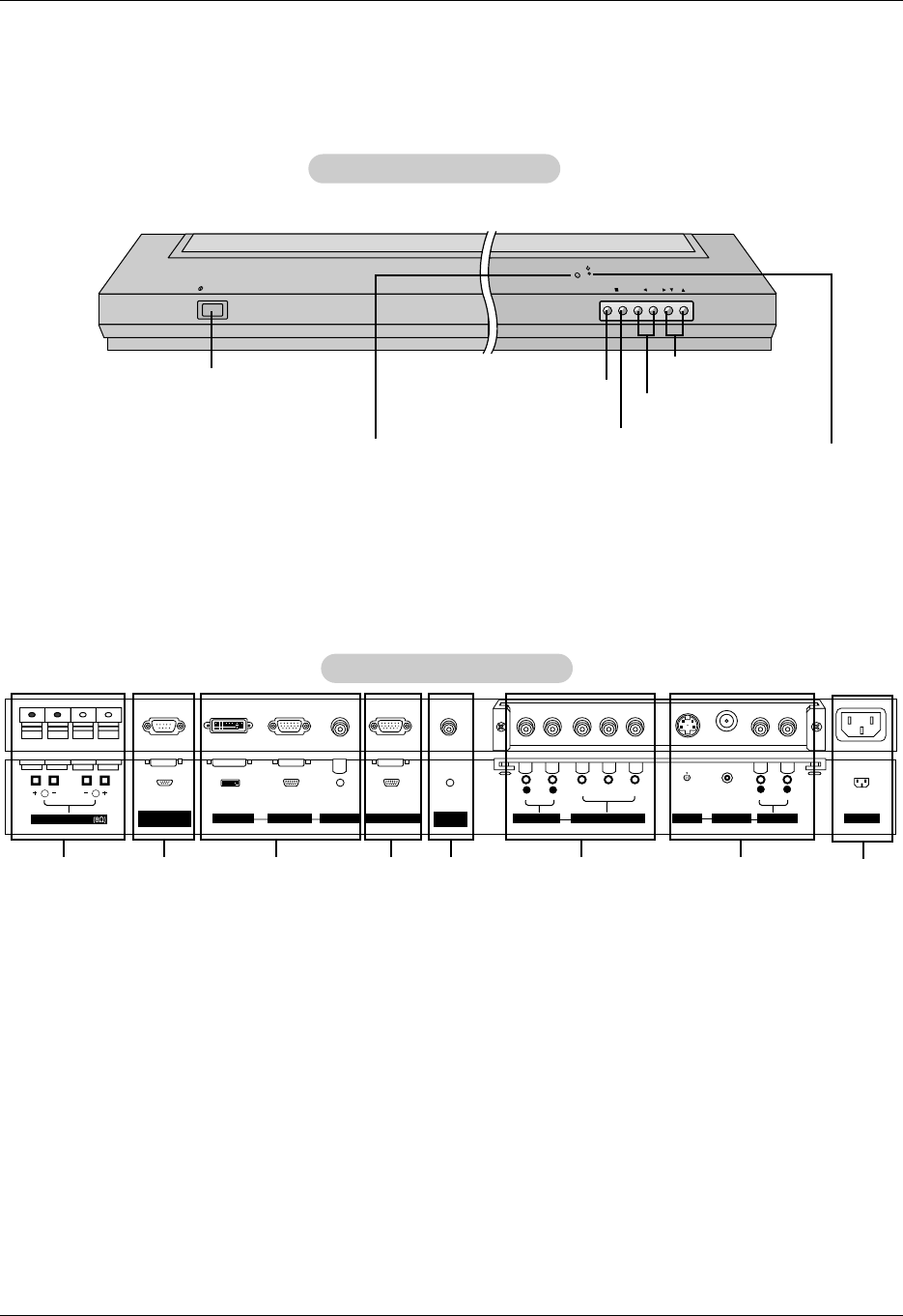
Owner’s Manual 7
Instruction
Controls
Controls
Connection Options
Connection Options
R
( )
( )
( )
( )
L
RS-232C INPUT
(CONTROL/SERVICE)
EXTERNAL SPEAKER
YP
B
P
R
(MONO)
R
AUDIO
L
R
AUDIO
L
S-VIDEO
AC INPUT
AUDIO INPUTVIDEO INPUT
AUDIO INPUT
AUDIO INPUT
REMOTE
CONTROL
COMPONENT INPUT
DVI INPUT RGB INPUT RGB OUTPUT
1
1. EXTERNAL SPEAKER (8 ohm output)
Connect to optional external speaker(s).
* For further information, refer to ‘Speaker & Speaker
Stand’manual.
2. RS-232C INPUT (CONTROL/SERVICE) PORT
Connect to the RS-232C port on a PC.
3. DVI (Digital Visual Interface) INPUT/
RGB INPUT/AUDIO INPUT JACKS
Connect the monitor output connector of a PC to the appro-
priate input port.
4. RGB OUTPUT JACKS
You can watch the RGB signal on another monitor, connect
RGB OUTPUT to another monitor’s PC input port. Note: In
standby mode, RGB output does not work.
5. REMOTE CONTROL
Connect your wired remote control to the remote control
port on the Monitor.
6. COMPONENT INPUT/AUDIO INPUT JACKS
7. S-VIDEO INPUTS
Connect video out from an S-VIDEO VCR to the S-VIDEO
input.
AUDIO/VIDEO INPUT JACKS
Connect audio/video out from external equipment to these
jacks.
8. POWER CORD SOCKET
This Monitor operates on an AC power. The voltage is indi-
cated on the Specifications page. Never attempt to operate
the Monitor on DC power.
Back Connection Panel
VOL.
MENU
INPUT
SELECT
ON/OFF
Main Power Button INPUT SELECT Button VOLUME (F,G) Buttons
Power Standby Indicator
Illuminates red in standby mode,
Illuminates green when the
Monitor is turned on
Remote Control Sensor MENU Button
E, D Buttons
Front Panel Controls
Front Panel Controls
2 4 53 7 8
6
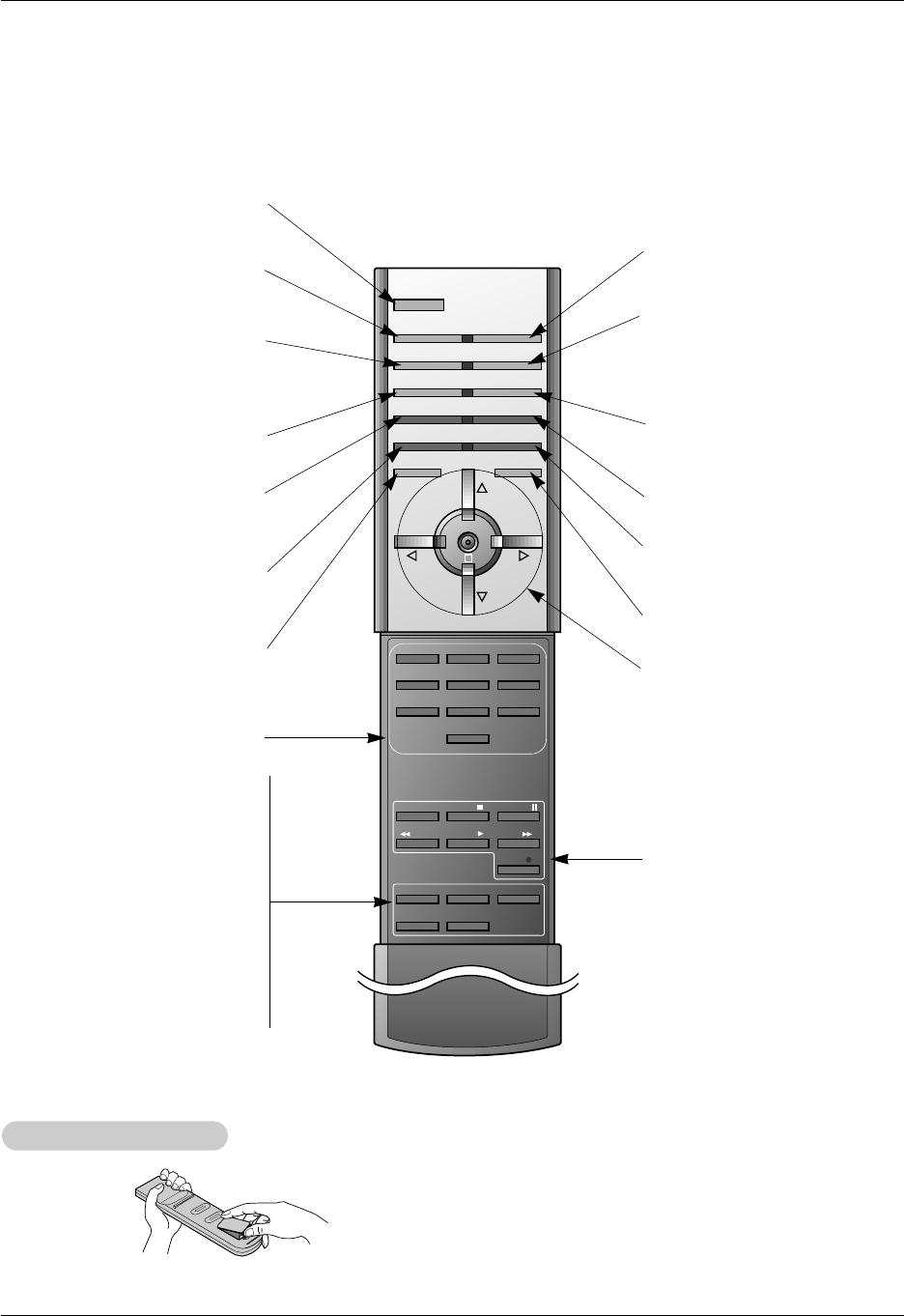
8 Plasma Display
Instruction
- When using the remote control, aim it at the remote control sensor on the monitor.
- Under certain conditions such as when the beam is interrupted, the remote control may not function. Press the key
again if necessary.
123
456
78
0
9
POWER
SLEEP INPUT SELECT
APC DASP
ARC PIP ARC
PIP
TWIN PICTURE
SWAP
MENU MUTE
OK
VOL
POWER STOP
PLAY FF
REC
REW
P/STILL
WIN.SIZE
WIN.POSITION
ZOOM +
ZOOM -
SPLIT ZOOM
VOL
SUB INPUT
POWER
Switches the Monitor on from
standby or off to standby.
SLEEP
Sets the sleep timer.
(Refer to p.18)
APC
Adjusts the factory preset picture
according to the room.
(Refer to p.16)
ARC
Changes the picture format.
(Refer to p.20)
PIP
Switches the sub picture on or off.
(Refer to p.23)
SWAP
Exchanges main and sub picture
images. (Refer to p.23, 24)
MENU
Displays on screen menus one by one.
Exits the current menu.
Memorizes menu changes.
NUMBER buttons
WIN. SIZE
Adjusts the sub picture size.
WIN.POSITION
Moves the sub picture.
SPLIT ZOOM
Enlarge the screen with regular
ration.
ZOOM-/ZOOM+
Enlarges or reduces
the main picture size.
VCR BUTTONS
Controls a LG video cassette
recorder.
OK
D / E
Selects a menu option.
F / G (Volume button)
Increases/decreases sound level.
Adjusts menu settings.
INPUT SELECT
Selects: Video,S-Video,RGB,DVI
or Component mode.
DASP
To select the sound appropriate to
your viewing program character:
Flat,Music, Cinema,Sports,or
User (Refer to p.17)
PIP ARC
Changes the PIP picture format.
(Refer to p.23)
SUB INPUT
Selects the input mode for the sub
picture.
MUTE
Switches the sound on or off.
TWIN PICTURE
(Refer to p.24)
•Open the battery compartment cover on the back side and
insert the batteries with correct polarity.
•Install two 1.5V alkaline batteries of AAA type. Don’t mix used
batteries with new batteries.
Installing Batteries
Installing Batteries
Remote Control Key Functions
Remote Control Key Functions
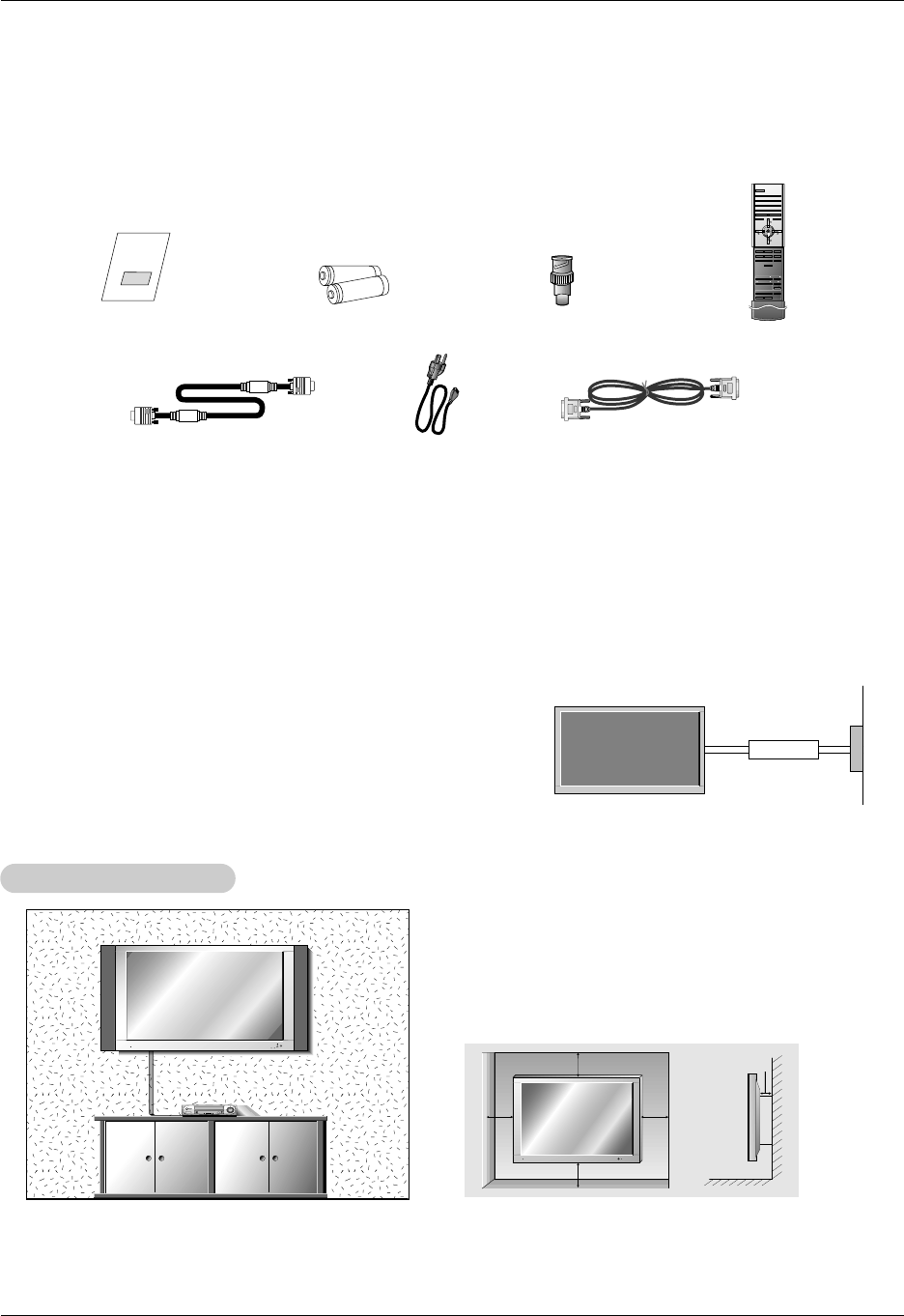
Owner’s Manual 9
Installation
Installation
Installation
D-sub 15 pin cable
Owner’s Manual
1.5V
1.5V
Alkaline batteries BNC-RCA adapter
Power Cord
123
456
78
0
9
POWER
SLEEP INPUT SELECT
APC DASP
ARC PIP ARC
PIP
TWIN PICTURE
SWAP
MENU MUTE
OK
VOL
POWER STOP
PLAY FF
REC
REW
P/STILL
WIN.SIZE
WIN.POSITION
ZOOM +
ZOOM -
SPLIT ZOOM
VOL
SUB INPUT
Remote Control
DVI Cable
Ensure that the following accessories are included with your plasma display. If an accessory is missing, please contact the dealer
where you purchased the product.
Installation Instructions
Installation Instructions
•The Monitor can be installed in various ways such such as on a wall, or on a desktop etc.
•The plasma display is designed to be mounted horizontally or vertically. The speakers depicted are optional.
GROUNDING
Ensure that you connect the grounding / earth wire to prevent possible
electric shock. If grounding methods are not possible, have a qualified
electrician install a separate circuit breaker. Do not try to ground the
unit by connecting it to telephone wires, lightening rods, or gas pipes.
Power
supplier
Short-circuit
breaker
4inch
4inch
4inch4inch
1.18inch
W
Wall Mount Installation
all Mount Installation
For proper ventilation, allow a clearance of 4” on each
side and 2” from the wall. Detailed installation instruc-
tions are included from your dealer in the optional Wall
Mounting Bracket Installation and Setup Guide.
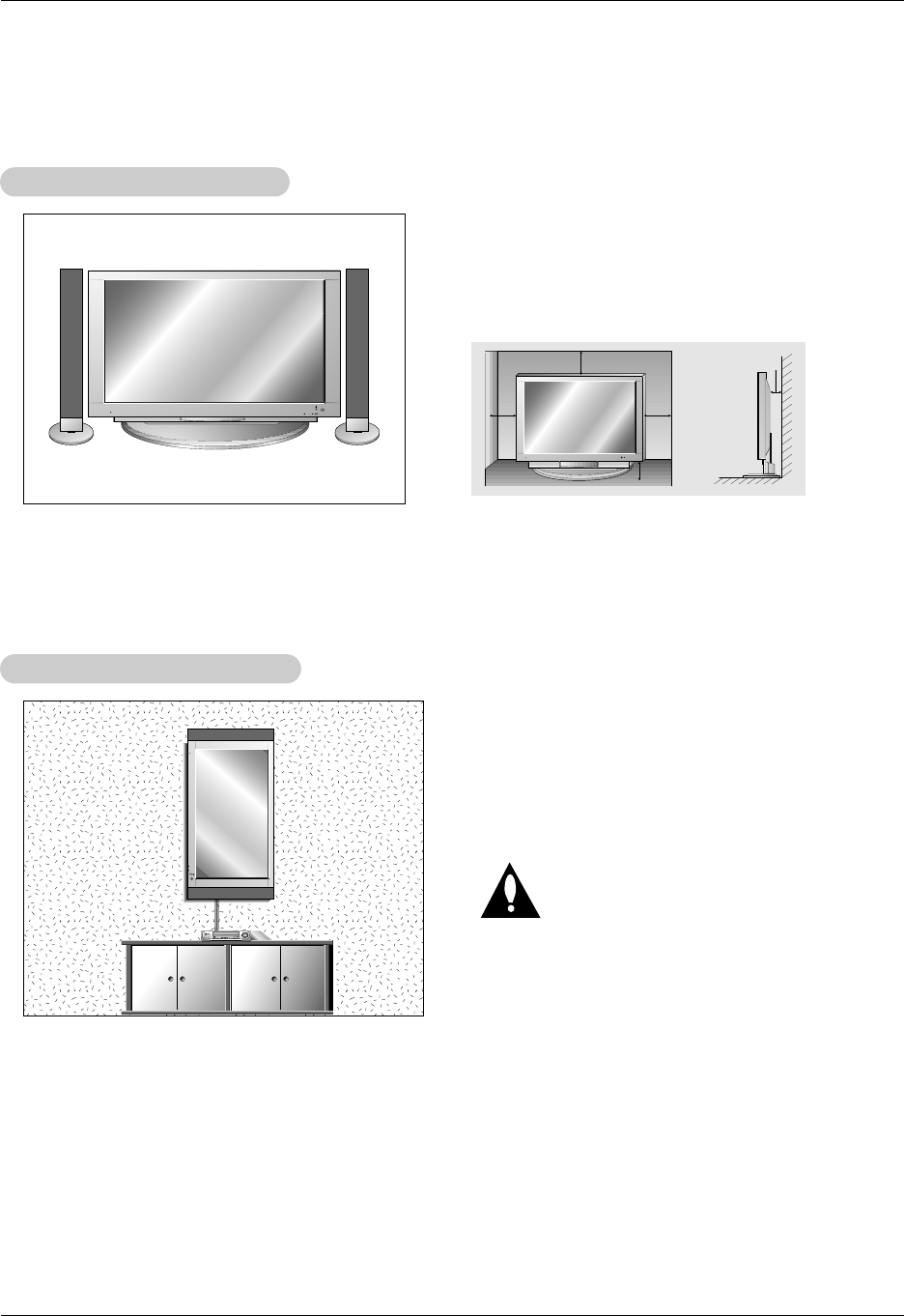
10 Plasma Display
Installation
Wall Mount: Vertical installation
Detailed installation instructions are included from your
dealer in the optional Vertical Wall Mounting Bracket
Installation and Setup Guide.
NOTE: When installing the monitor vertically, the front
panel controls must be in the left side position.
When installing the monitor vertically, you
have to change the OSD display mode so
that the menus will appear correctly and also
to protect the monitor from overheating
(Refer to P. 19).
4inch
4inch
2.36inch
4inch
1.18inch
Desktop Pedestal Installation
Desktop Pedestal Installation
ON/OFF
INPUT
SELECT VOLUME
For proper ventilation, allow a clearance of 4” on each
side and the top, 2.36” on the bottom, and 2” from the
wall. Detailed installation instructions are included from
your dealer in the optional Desktop Stand Installation and
Setup Guide.
Installation Instructions continued
Installation Instructions continued
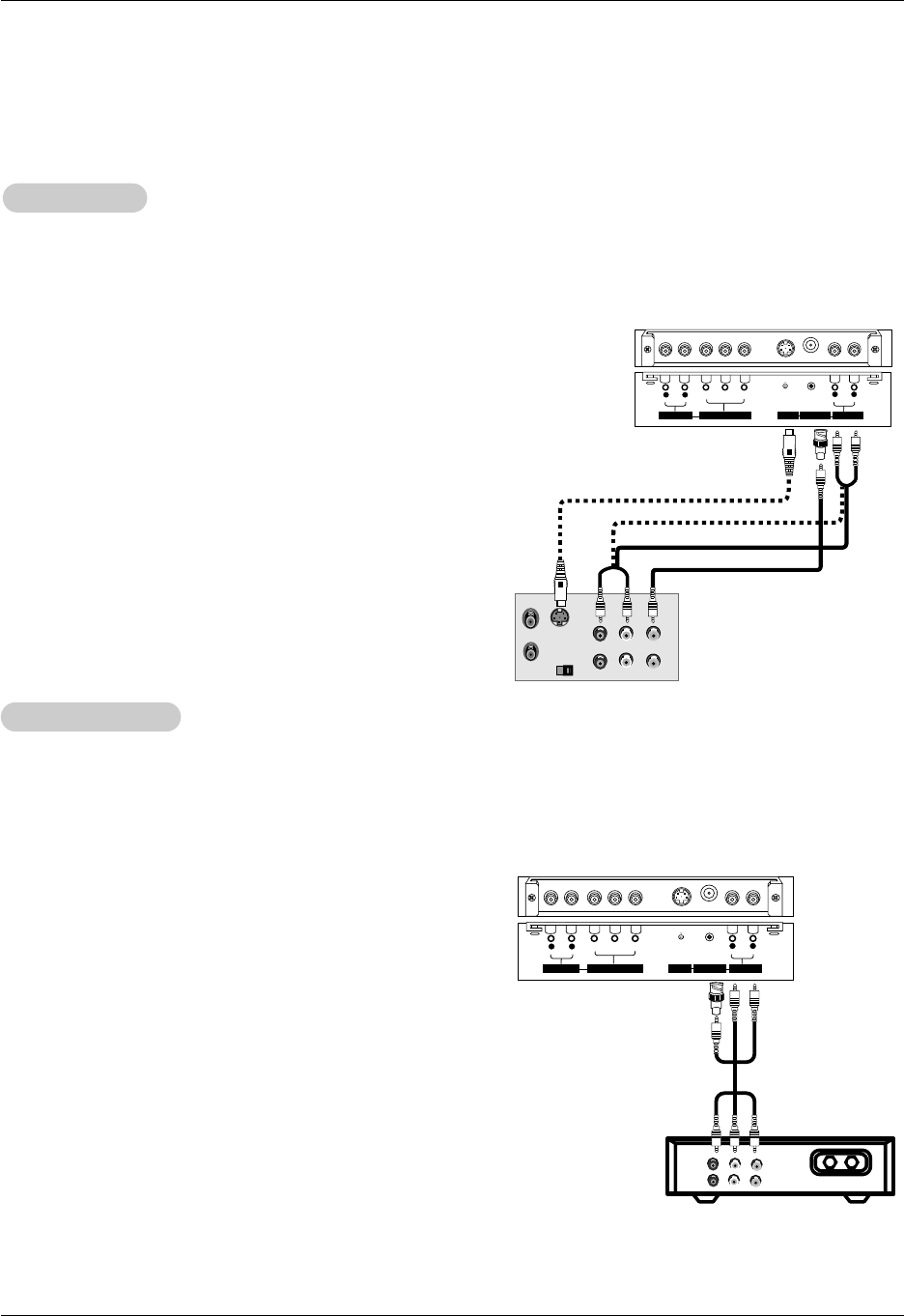
Owner’s Manual 11
Installation
External Equipment Connections
External Equipment Connections
NOTE: Not all depicted cables are included with the plasma display.
- To avoid picture noise (interference), leave an adequate distance between the VCR and Monitor
- Use the orbiter function to Avoid having a fixed image remain on the screen for a long period of time. Typically a frozen still pic-
ture from a VCR. If a 4:3 picture format is used; the fixed image may remain visible on the screen.
How to connect
1. Connect the provided BNC-RCA adapter to the monitor’s VIDEO
INPUT.
2. Connect the audio and video cables between the VCR's output
jacks and the monitor input jacks, as shown in the figure. When con-
necting the monitor to VCR, match the colors of connecting jacks
(Video = yellow, Audio Left = white, and Audio Right = red).
Mono VCR: Connect the video output cable from the VCR to the
VIDEO input.
S-VIDEO VCR: Connect the S-Video output cable from the VCR to
the S-VIDEO input. (Note that S-Video offers higher quality).
How to use
1. Insert a video tape into the VCR and press PLAY on the VCR.
(Refer to the VCR owner’s manual.)
2. Use the INPUT SELECT button on the remote control to select
Video.
(If connected to S-VIDEO, select the S-Video external input source.)
VCR Setup
VCR Setup
S-VIDEO OUT
IN
(R) AUDIO (L) VIDEO
YP
B
P
R
(MONO)
R
AUDIO
L
R
AUDIO
L
S-VIDEO
AUDIO INPUTVIDEO INPUT
AUDIO INPUT COMPONENT INPUT
- After subscribing to a cable TV service from a local provider and installing a converter, you can watch cable TV programming.
The monitor cannot display TV programming unless a TV tuner device or cable TV converter box is connected to the Monitor.
- For further information regarding cable TV service, contact your local cable TV service provider(s).
How to connect
1. Connect the provided BNC-RCA adapter to the monitor’s VIDEO
INPUT.
2. Connect the audio and video cables between the cable TV's output
jacks and the monitor input jacks, as shown in the figure.
When connecting the monitor to VCR, match the colors of connect-
ing jacks (Video = yellow, Audio Left = white, and Audio Right = red).
How to use
1. Use the INPUT SELECT button on the remote control to select
Video.
2. Select your desired channel with the remote control for cable box.
Cable
Cable TV Setup
TV Setup
TV
VCR RF Cable
(R) AUDIO (L) VIDEO
YP
B
P
R
(MONO)
R
AUDIO
L
R
AUDIO
L
S-VIDEO
AUDIO INPUTVIDEO INPUT
AUDIO INPUT
COMPONENT INPUT
VCR
Cable TV
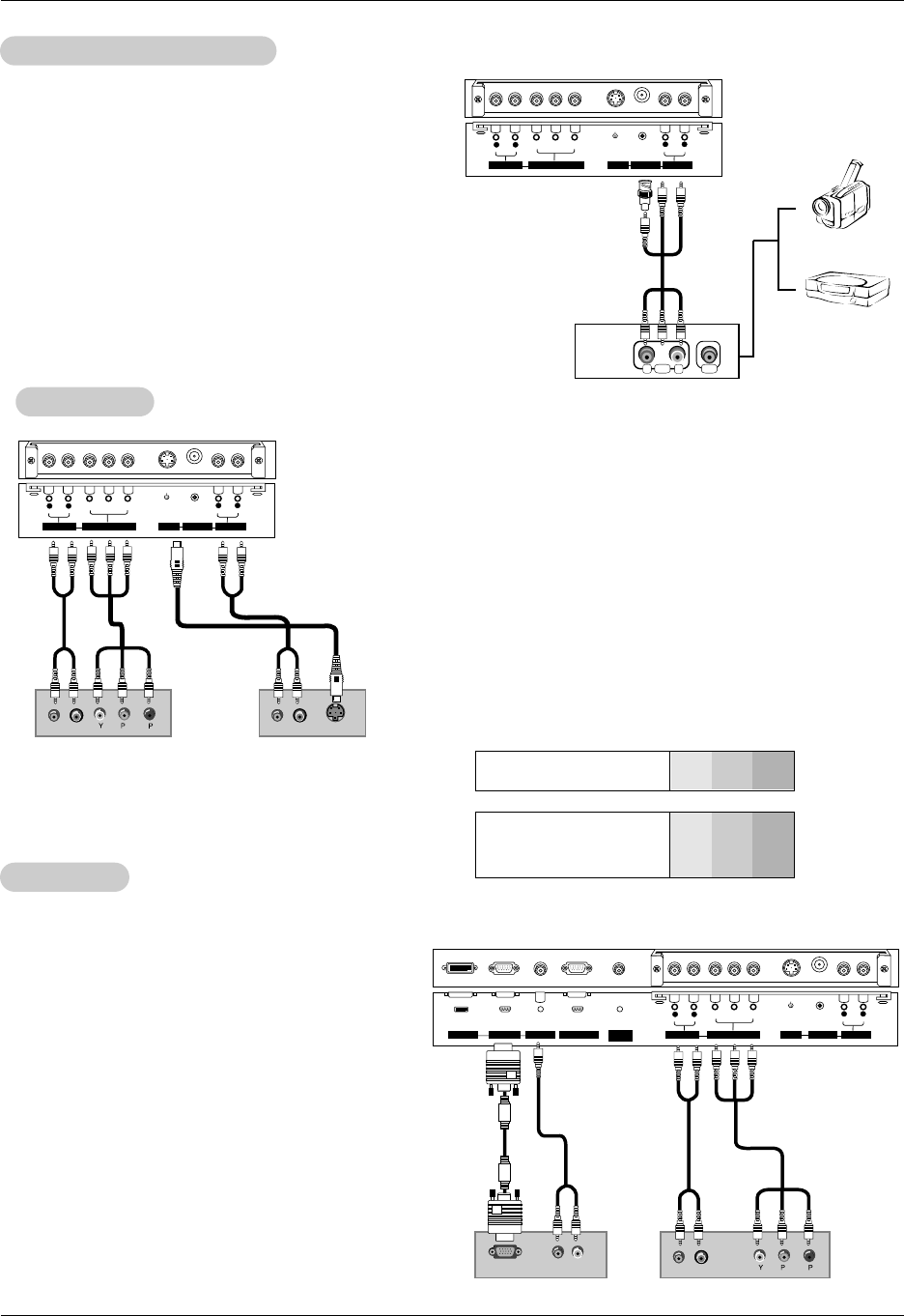
12 Plasma Display
Installation
•Component Input ports
To get better picture quality, connect a DVD player to the compo-
nent input ports as shown below.
- To watch digitally broadcast programs, purchase and
connect a digital set-top box.
- This monitor supports HDCP (High-bandwidth Digital
Contents Protection) protocol for DVI DTV
(480p,720p,1080i) mode.
How to connect
1. Connect the DTV set-top box video output to the mon-
itor’s COMPONENT (Y, PB, PR) INPUT and audio
jacks.
2. If the box has an RGB connector, connect it to the
monitor’s RGB INPUT connector and the audio input
jack.
How to use
1. Turn on the digital set-top box. (Refer to the owner’s
manual for the digital set-top box.)
2. Use INPUT SELECT on the remote control to select
Component, RGB or DVI.
DTV Setup
DTV Setup
How to connect
1. Connect the provided BNC-RCA adapter to the monitor’s
VIDEO INPUT.
2. Connect the audio and video cables between the external
equipment's output jacks and the monitor input jacks, as
shown in the figure. When connecting the monitor to exter-
nal equipment, match the colors of connecting jacks (Video
= yellow, Audio Left = white, and Audio Right = red).
How to use
1. Use the INPUT SELECT button on the remote control to
select Video.
2. Operate the corresponding external equipment. Refer exter-
nal equipment operating guide.
Component ports of the
Monitor Y PBPR
Video output ports
of DVD player
Y
Y
Y
Y
Pb
B-Y
Cb
PB
Pr
R-Y
Cr
PR
How to connect
1. Connect the DVD video outputs to the COMPONENT (Y, PB, PR)
INPUT jacks and connect the DVD audio outputs to the AUDIO
INPUT jacks, as shown in the figure.
2. If your DVD only has an S-Video output jack, connect this to the
S-VIDEO input on the monitor and connect the DVD audio outputs
to the AUDIO INPUT jacks, as shown in the figure.
How to use
1. Turn on the DVD player, insert a DVD
2. Use the INPUT SELECT button on the remote control to select
Component. Refer to the DVD player's manual for operating
instructions.
External
External A/V Source Setup
A/V Source Setup
DVD Setup
DVD Setup
RL
AUDIO VIDEO
Video game set
Camcorder
YP
B
P
R
(MONO)
R
AUDIO
L
R
AUDIO
L
S-VIDEO
AUDIO INPUTVIDEO INPUT
AUDIO INPUT
COMPONENT INPUT
YP
B
P
R
(MONO)
R
AUDIO
L
R
AUDIO
L
S-VIDEO
AUDIO INPUTVIDEO INPUT
AUDIO INPUT
AUDIO INPUT
REMOTE
CONTROL
COMPONENT INPUT
DVI INPUT RGB INPUT RGB OUTPUT
BR
(R) AUDIO (L)
DTV OUTPUT
(R) AUDIO (L)
BR
(R) AUDIO (L) (R) AUDIO (L)
S-VIDEO
YP
B
P
R
(MONO)
R
AUDIO
L
R
AUDIO
L
S-VIDEO
AUDIO INPUTVIDEO INPUT
AUDIO INPUT
COMPONENT INPUT
DVD
Digital Set-top box
or
or
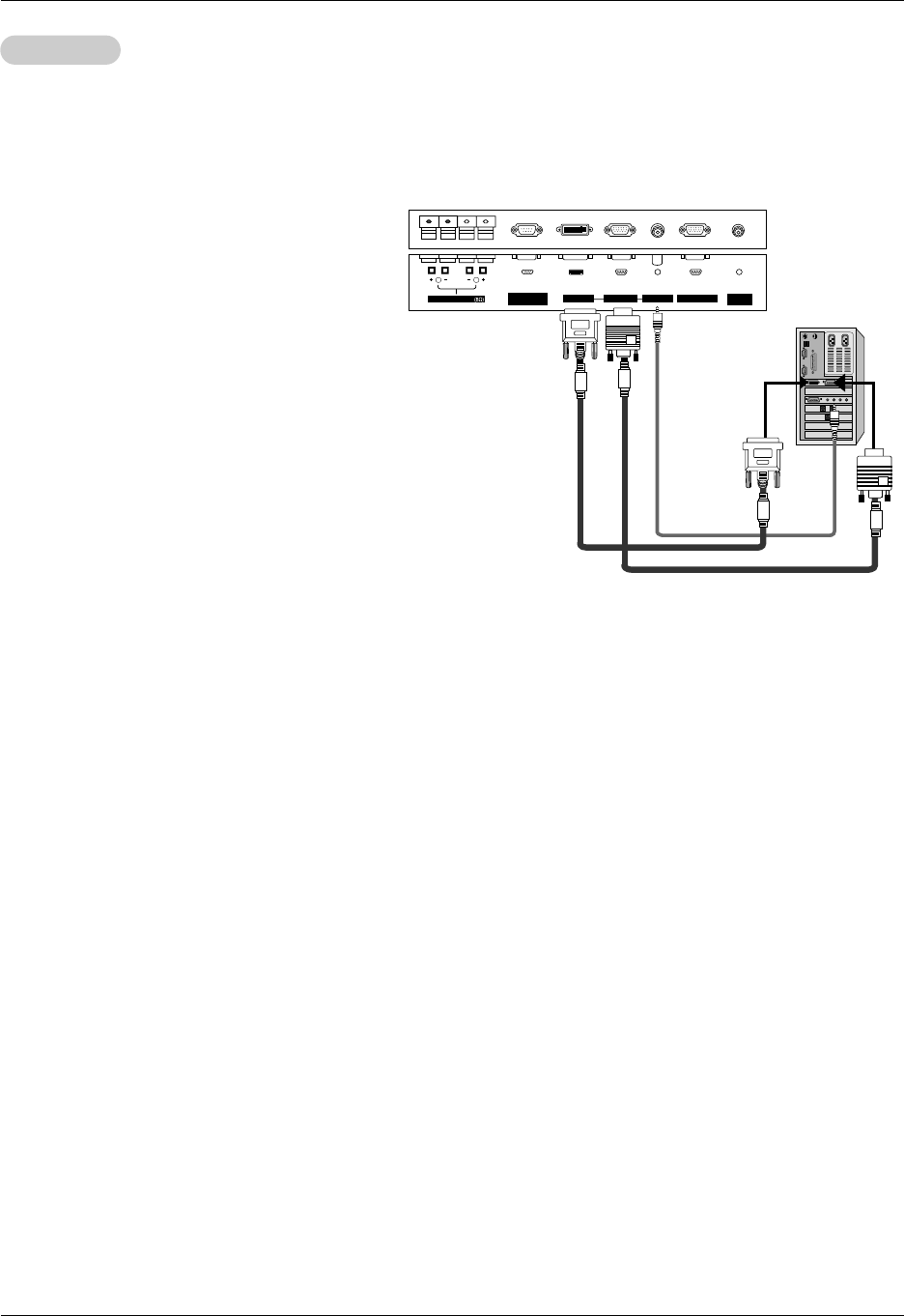
Owner’s Manual 13
Installation
How to connect
1. To get the best picture quality, adjust the PC
graphics card to a 1024x768, 60Hz or 1366x768,
75 Hz. Resolutions over UXGA cannot be dis-
played.
2. Connect the signal cable from the PC video output
port to the monitor’s RGB INPUT port, or the PC's
DVI (Digital Visual Interface) output port to the
monitor’s DVI INPUT port. If the graphic card on
the PC does not output analog and digital RGB
simultaneously, connect only one of both RGB
INPUT or DVI INPUT to display the PC on the
monitor.
If the graphic card on the PC does output analog
and digital RGB simultaneously, set the monitor to
either RGB or DVI; (the other mode is set to Plug
and Play automatically by the monitor.)
3. Connect the audio cable from the PC to the
AUDIO INPUT jacks on the plasma display. If
using a sound card, adjust the PC sound as
required.
How to use
1. Turn on the PC and the monitor.
2. Turn on the display by pressing the POWER button on the monitor's remote control.
3. Use the INPUT SELECT button on the remote control to select the RGB or DVI.
4. Check the image on your monitor. There may be noise associated with the resolution, vertical pattern, contrast or
brightness in PC mode. If noise is present, change the PC mode to another resolution, change the refresh rate to
another rate or adjust the brightness and contrast on the menu until the picture is clear. If the refresh rate of the PC
graphic card can not be changed, change the PC graphic card or consult the manufacturer of the PC graphic card.
NOTES: • Depending on the graphics card, DOS mode may not work if you use a DVI-I cable.
• Avoid keeping a fixed image on the monitor's screen for a long period of time.The fixed image may become
permanently imprinted on the screen. Use the Orbiter screen saver when possible.
• The synchronization input form for Horizontal and Vertical frequencies is separate.
PC Setup
PC Setup
R
( )
( )
( )
( )
L
RS-232C INPUT
(CONTROL/SERVICE)
EXTERNAL SPEAKER
AUDIO INPUT
REMOTE
CONTROL
DVI INPUT RGB INPUT RGB OUTPUT
This plasma display provides Plug and Play capability, meaning that the PC adjusts automatically to its settings. The plasma dis-
play sends configuration information (EDID) to the PC using the Video Electronics Standard Association (VESA) Display Data
Channel (DDC) protocol. It perceives the 640x480 resolution at 60 Hz to provide the Advanced Television Systems Committee
(ATSC) 480P or 480-line progressive-scan television video signaling standard that is part of the Digital Television (DTV) standard
for 60 frame-per-second video.
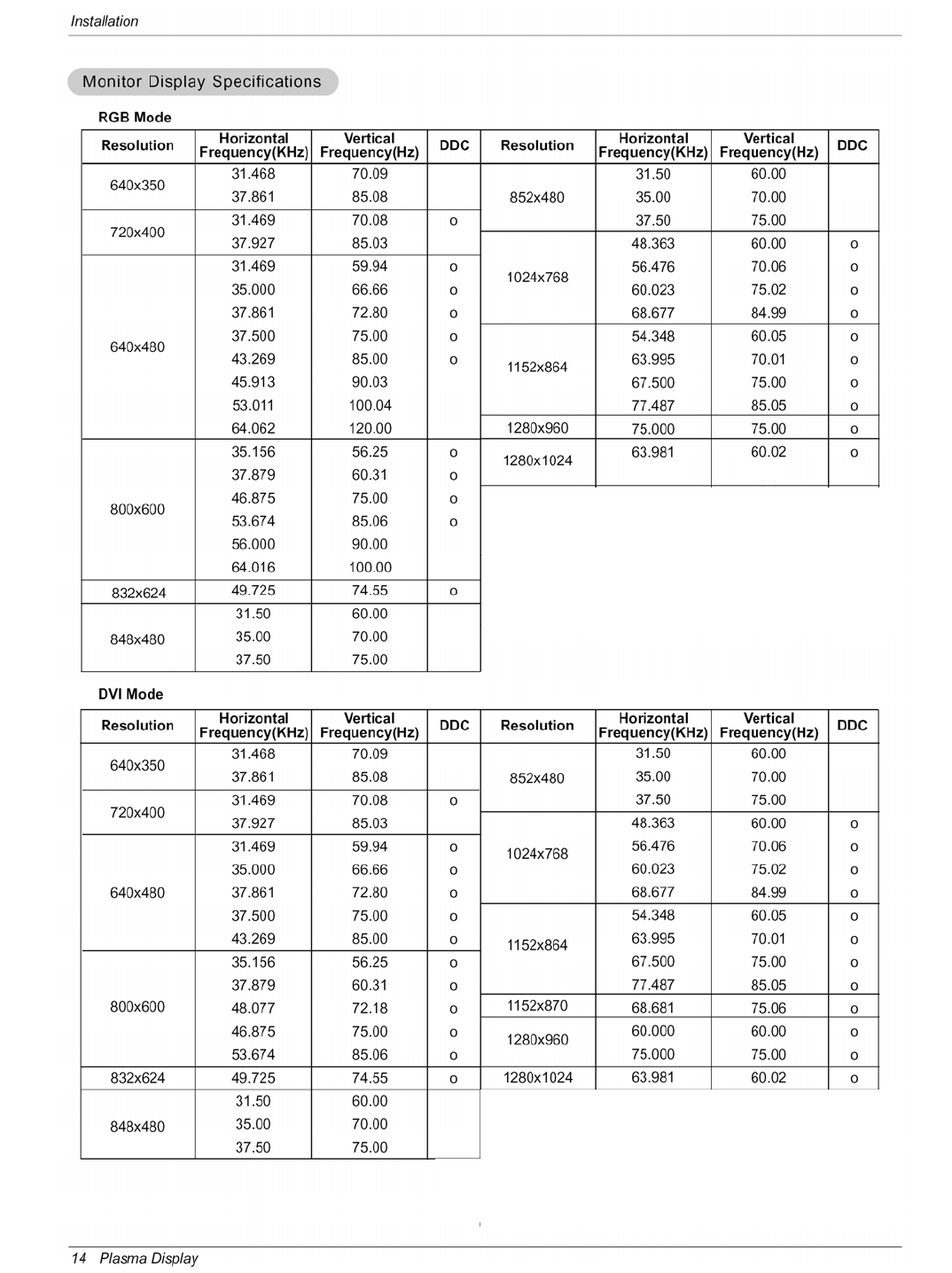
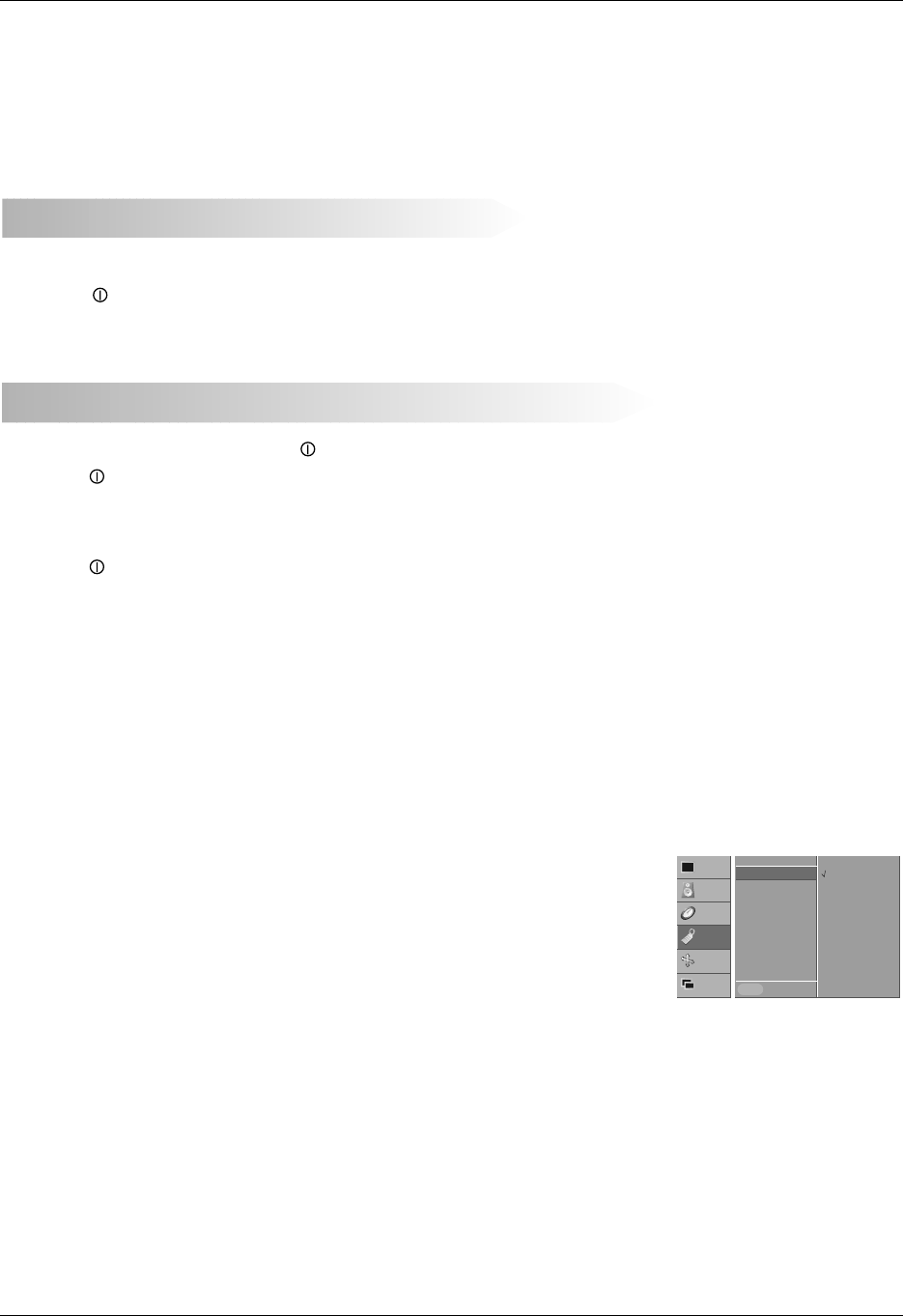
Owner’s Manual 15
Operation
Operation
Operation
Menu Language Selection
Menu Language Selection
T
Turning on the Monitor
urning on the Monitor
Turning on the Monitor just after installation
Turning on the Monitor (power cord is still connected)
1. Connect power cord correctly.
2. Press the ON/OFF button on the Monitor. At this moment, the Monitor is switched to standby
mode. Press the INPUT SELECT button on the Monitor or press the POWER, INPUT SELECT but-
ton on the remote control and then the Monitor will switch on.
•Press the ON/OFF button on the Monitor to turn the Monitor on.
1. If the Monitor was turned off with the ON/OFF button on the Monitor
2. If the Monitor was turned off with the remote control or the ON/OFF button on the Monitor
•Press the ON/OFF button on the Monitor and then press the INPUT SELECT button on the
Monitor or press the POWER, INPUT SELECT button on the remote control to turn the Monitor on.
-The menus can be shown on the screen in the selected language. First select your language.
1. Press the MENU button and then use D/ Ebutton to select the SPECIAL menu.
2. Press the Gbutton and then use D/ Ebutton to select Language.
3. Press the Gbutton and then use D/ Ebutton to select your desired language.
From this point on, the on-screen menus will be shown in the language of your choice.
4. Press the MENU button to save and return to the previous menu.
한국어
VIDEO
AUDIO
TIME
SCREEN
TWIN
SPECIAL
Language G
Key lock
ISM method
Low power
Set id.
OSD rotate
English
Español
Português
Français
MENU Prev.
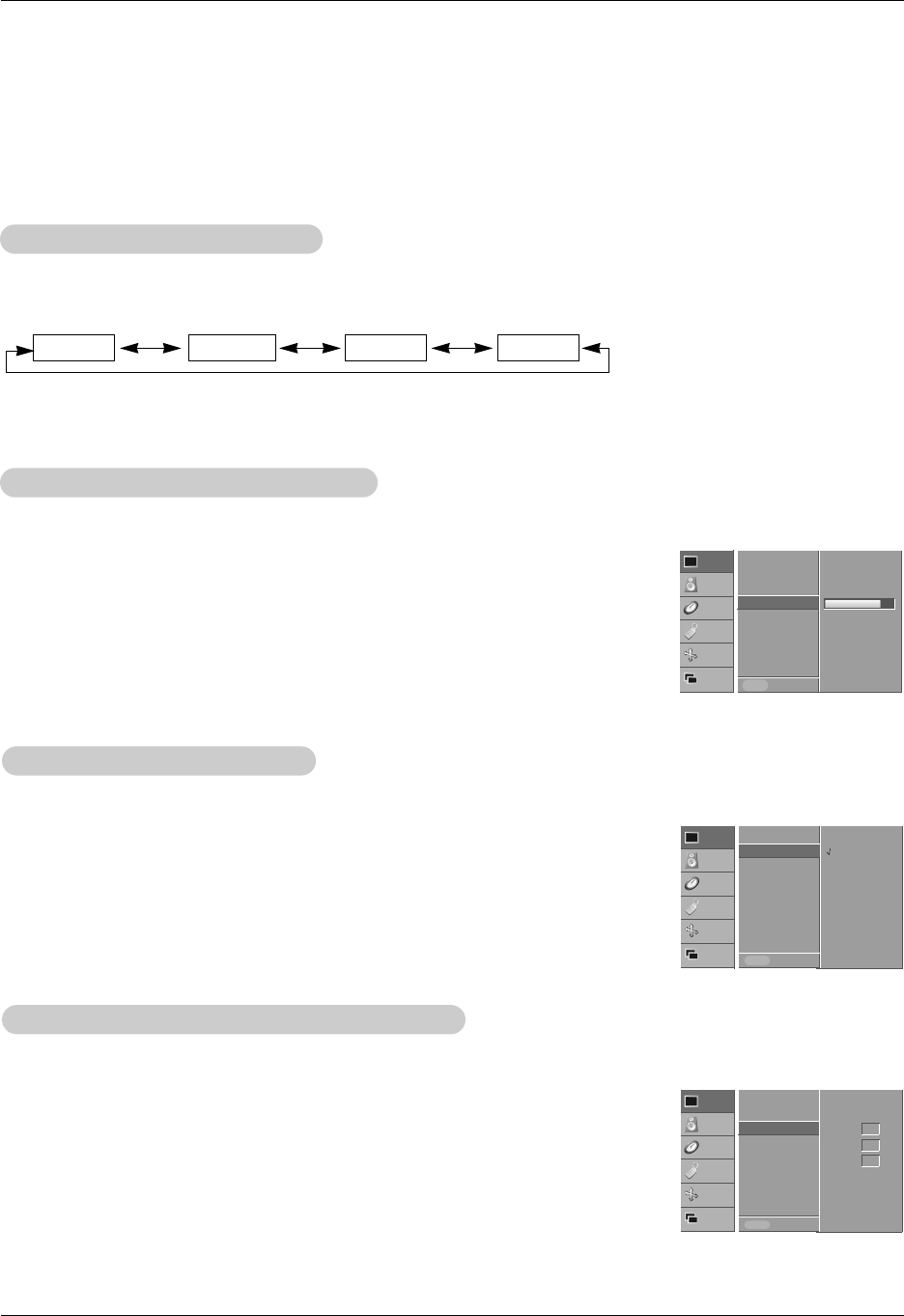
16 Plasma Display
Operation
- You can adjust picture contrast, brightness, color, sharpness and tint to the levels you prefer.
- PIP settings are not adjustable.
1. Press the MENU button and then use D / Ebutton to select the VIDEO menu.
2. Press the Gbutton and then use D / Ebutton to select the desired picture option
(Contrast,Brightness,Color,Sharpness,Tint).
3. Press the Gbutton and then use F / Gbutton to make appropriate adjustments.
4. Press the MENU button to save and return to the previous menu.
1. Press the APC button repeatedly to select the picture appearance setup option as shown below.
APC (Auto Picture Control)
APC (Auto Picture Control)
Manual Picture Control (
Manual Picture Control (User option)
option)
- To initialize values (reset to default settings), select the Normal option.
1. Press the MENU button and then use D / Ebutton to select the VIDEO menu.
2. Press the Gbutton and then use D / Ebutton to select ACC .
3. Press the D / Ebutton to select either Normal (Default), Cool (Preset), Warm
(Preset) or User (Manual Adjustment).
4. Press the MENU button to save and return to the previous menu.
Adjusting
Adjusting Auto Color Control
Auto Color Control
- This function adjusts the Monitor to the best picture appearance.
- You can adjust red, green, or blue to any color temperature you prefer.
1. Press the MENU button and then use D / Ebutton to select the VIDEO menu.
2. Press the Gbutton and then use D / Ebutton to select the Color temp .
3. Press the Gbutton and then use D / Ebutton to select Red, Green or Blue.
4. Use the F / Gbutton to make appropriate adjustments.
• The adjustment range of Red, Green,and Blue is -10 ~ +10.
5. Press the MENU button to save and return to the previous menu.
Manual Color
Manual Color T
Temperature Control (
emperature Control (User option)
option)
VIDEO
AUDIO
TIME
SCREEN
TWIN
SPECIAL
APC
ACC
Color temp.
Contrast 85 G
Brightness 60
Color 50
Sharpness 50
Tint 0
MENU Prev.
VIDEO
AUDIO
TIME
SCREEN
TWIN
SPECIAL
APC
ACC G
Color temp.
Contrast 85
Brightness 60
Color 50
Sharpness 50
Tint 0
Normal
Cool
Warm
User
MENU Prev.
0
0
0
VIDEO
AUDIO
TIME
SCREEN
TWIN
SPECIAL
APC
ACC
Color temp. G
Contrast 85
Brightness 60
Color 50
Sharpness 50
Tint 0
Red
Green
Blue
MENU Prev.
- Each adjustment for video menu options doesn’t effect other input source. Readjust Video menu for
each following mode.
: RGB (PC) / DVI (DVI),
: RGB (DTV) / DVI (DTV) / Component (480p, 720p, 1080i)
: Video / S-Video / Component (480i)
V
Video Menu Options
ideo Menu Options
•You can also select Clear, Optimum, Soft or User in the VIDEO menu.
•Clear, Optimum and Soft are preset for good picture quality at the factory and cannot be changed.
Clear Optimum Soft User
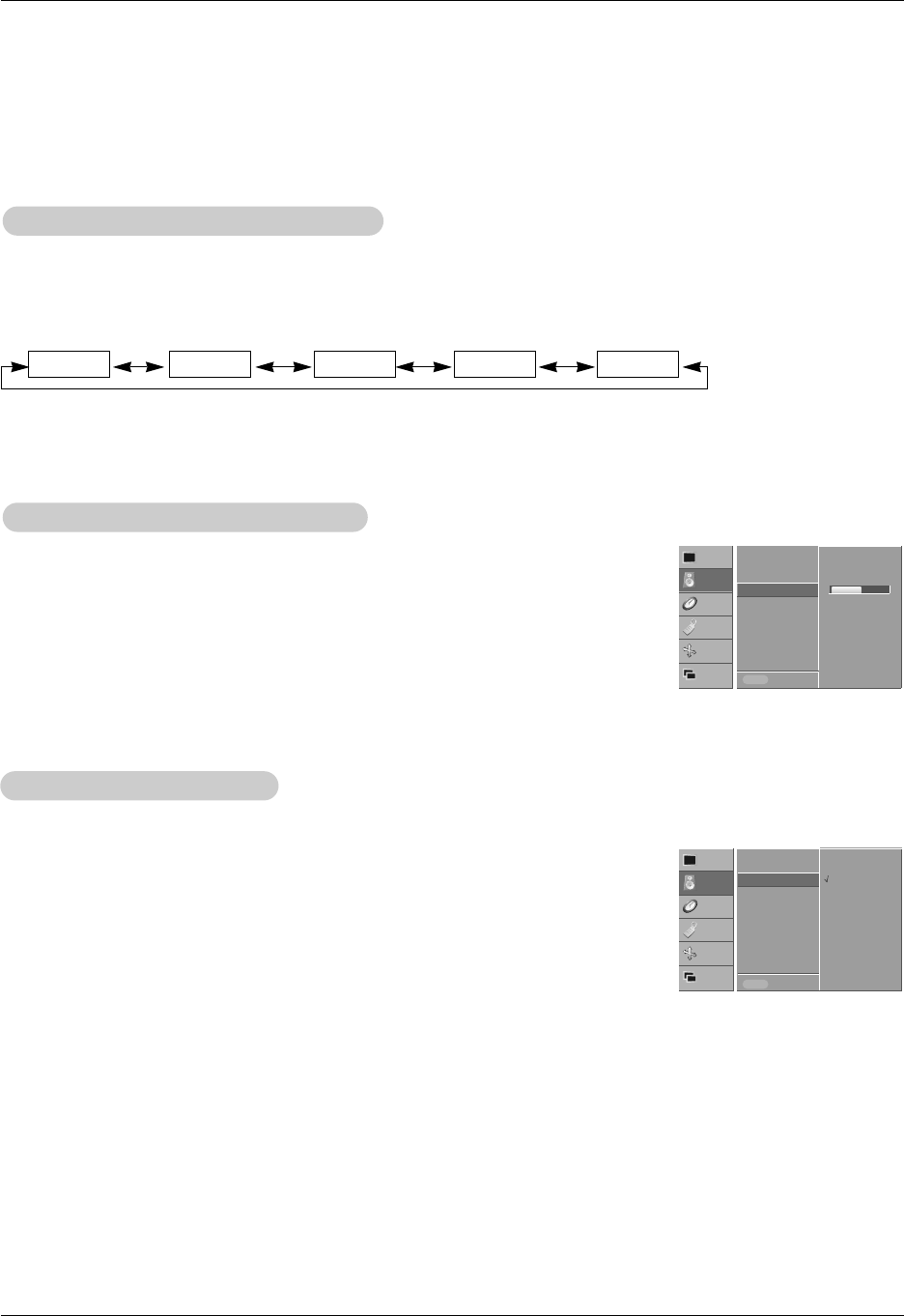
Owner’s Manual 17
Operation
Audio Menu Options
Audio Menu Options
1. Use the DASP button repeatedly to select the appropriate sound setup as shown below.
DASP
DASP (Digital
(Digital Auto Sound Processing)
Auto Sound Processing)
1. Press the MENU button and then use D / Ebutton to select the AUDIO menu.
2. Press the Gbutton and then use D / Ebutton to select the desired sound option
(Balance,Treble,Bass).
3. Press the Gbutton and then use F / Gbutton to make appropriate adjustments.
4. Press the MENU button to save and return to the previous menu.
Manual Sound Control (
Manual Sound Control (User option)
option)
- This function lets you enjoy the best sound without any special adjustment because the Monitor automatically
selects the appropriate sound option based on the program content.
- When adjusting sound options (treble, bass, and balance) manually, DASP automatically changes to User.
- This feature maintains an equal volume level; even if you change channels.
1. Press the MENU button and then use D / Ebutton to select the AUDIO menu.
2. Press the Gbutton and then use D / Ebutton to select AV L .
3. Press the Gbutton and then use D / Ebutton to select On or Off.
4. Press the MENU button to save and return to the previous menu.
A
AVL
VL (Auto V
(Auto Volume Leveler)
olume Leveler)
VIDEO
AUDIO
TIME
SCREEN
TWIN
SPECIAL
DASP
AVL
Balance 0
Treble 50 G
Bass 50
MENU PREV.
VIDEO
AUDIO
TIME
SCREEN
TWIN
SPECIAL
DASP
AVL G
Balance 0
Treble 50
Bass 50
On
Off
MENU PREV.
•You can also select Flat, Music, Cinema, Sports, or User in the AUDIO menu.
•Flat, Music, Cinema and Sports are preset for good sound quality at the factory and cannot be
changed.
Flat Music Cinema Sports User
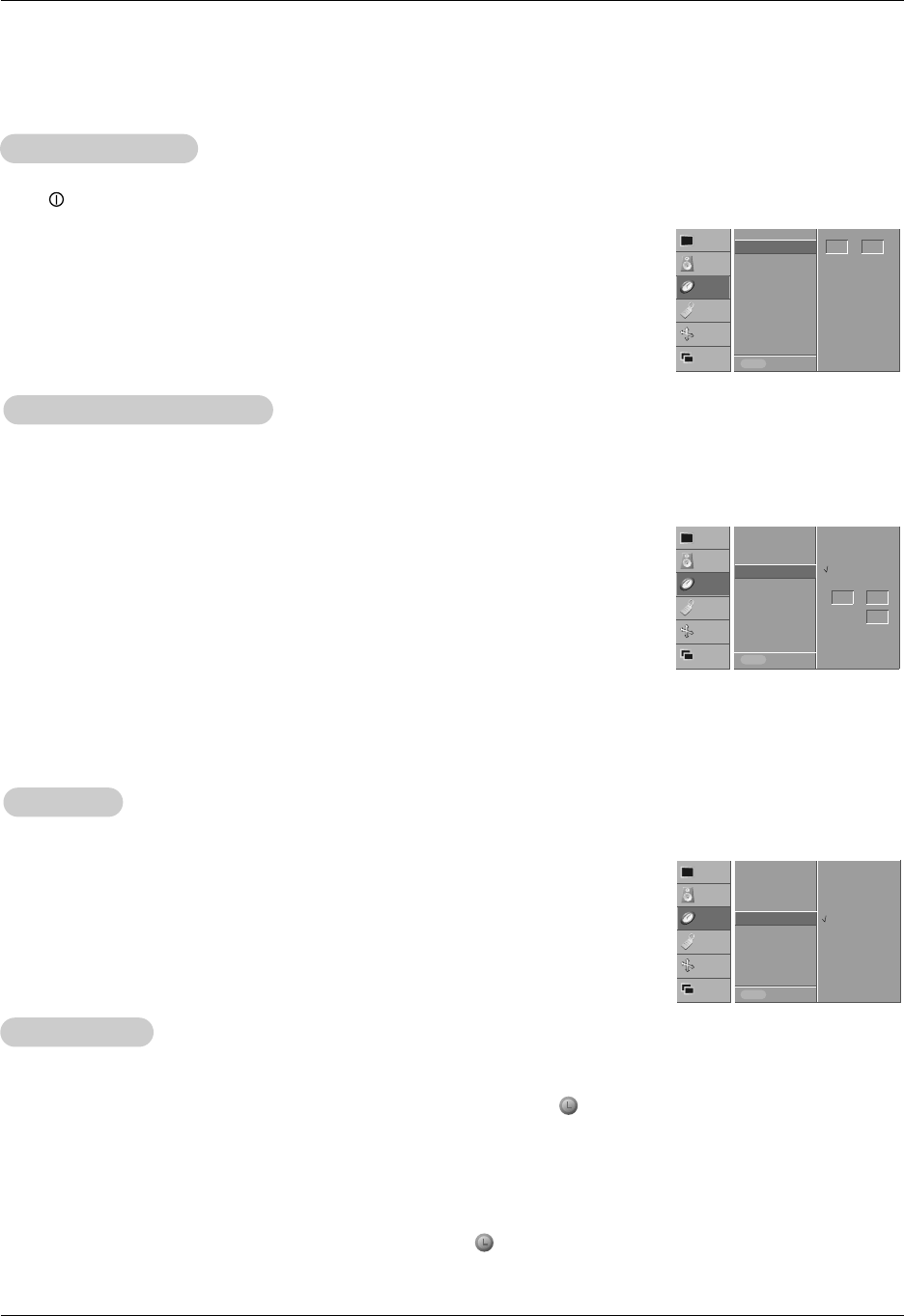
18 Plasma Display
Operation
- Timer function operates only if current time has been already set.
- Off-Timer function overrides On-Timer function if they are set to the same time.
- The monitor must be in standby mode for the On Timer to work.
Setting the On/Of
Setting the On/Off
f T
Timer
imer
1. Press the MENU button and then use D / Ebutton to select the TIME menu.
2. Press the Gbutton and then use D / Ebutton to select Off timer or On timer.
3. Press the Gbutton and then use D / Ebutton to select On.
• To cancel On/Off timer function, select Off.
4. Press the Gbutton and then use D / Ebutton to set the hour.
5. Press the Gbutton and then use D / Ebutton to set the minutes.
6. For only On timer function; Press the Gbutton and then use D / Ebutton to set
volume level.
6. Press the MENU button to save and return to the previous menu.
Auto Of
Auto Off
f
- If there is no input signal, the Monitor turns off automatically after 10 minutes.
1. Press the MENU button and then use D / Ebutton to select the TIME menu.
2. Press the Gbutton and then use D / Ebutton to select Auto off.
3. Press the Gbutton and then use D / Ebutton to select On or Off.
4. Press the MENU button to save and return to the previous menu.
12 00
30
:
VIDEO
AUDIO
TIME
SCREEN
TWIN
SPECIAL
Clock
Off timer
On timer G
Auto off
Off
On
Vol.
MENU Prev.
VIDEO
AUDIO
TIME
SCREEN
TWIN
SPECIAL
Clock
Off timer
On timer
Auto off GOff
On
MENU Prev.
Setting the Clock
Setting the Clock
- If current time setting is erased by a power failure, if TV is unplugged or if the monitor is turned off with
the ON/OFF button on the monitor, reset the clock.
1. Press the MENU button and then use D / Ebutton to select the TIME menu.
2. Press the Gbutton and then use D / Ebutton to select Clock.
3. Press the Gbutton and then use D / Ebutton to set the hour.
4. Press the Gbutton and then use D / Ebutton to set the minutes.
5. Press the MENU button to save and return to the previous menu.
-- --:
VIDEO
AUDIO
TIME
SCREEN
TWIN
SPECIAL
Clock G
Off timer
On timer
Auto off
MENU Prev.
T
Time Menu Options
ime Menu Options
Sleep
Sleep T
Timer
imer
- The sleep timer turns the Monitor off at a preset time. Note that this setting is cleared when the monitor is turned off.
1. Press the SLEEP button repeatedly to select the number of minutes. First the --- Min option appears on the
screen, followed by the following sleep timer options:
10, 20, 30, 60, 90, 120, 180, and 240 minutes.
2. When the number of minutes you want is displayed on the screen, press the OK button. The timer begins to count
down from the number of minutes selected.
3. To check the remaining minutes before the monitor turns off, press the SLEEP or OK button once.
4. To cancel the Sleep Timer, press the SLEEP button repeatedly until --- Min appears.
zz
zz
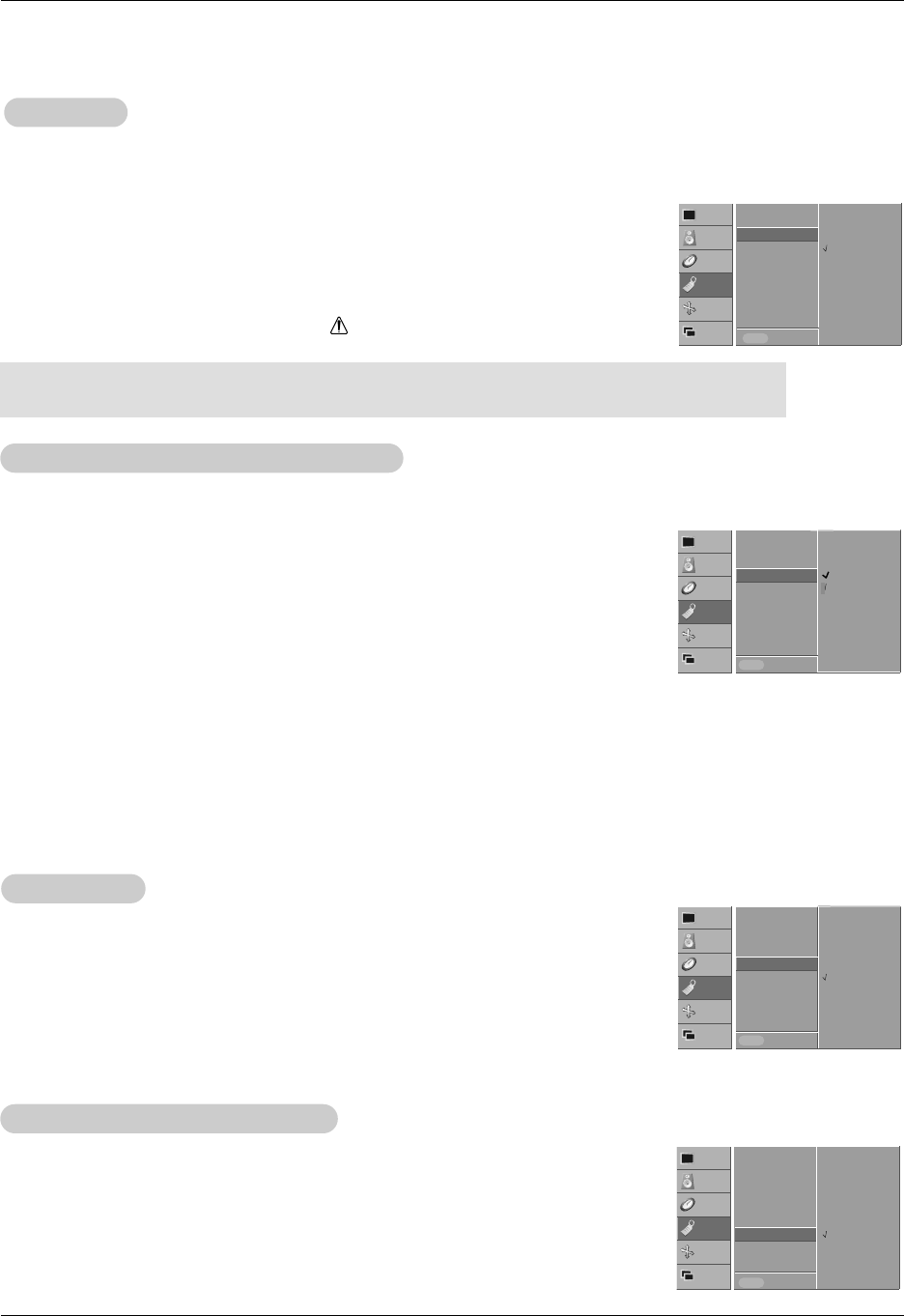
Owner’s Manual 19
Operation
Special Menu Options
Special Menu Options
VIDEO
AUDIO
TIME
SCREEN
TWIN
SPECIAL
Language
Key lock
ISM method G
Low power
Set id.
OSD rotate
Normal
White wash
Orbiter
Inversion
MENU Prev.
VIDEO
AUDIO
TIME
SCREEN
TWIN
SPECIAL
language
Key lock
ISM method
Low power G
Set id.
OSD rotate
On
Off
MENU Prev.
VIDEO
AUDIO
TIME
SCREEN
TWIN
SPECIAL
Language
Key lock
ISM method
Low power
Set id.
OSD rotate G
MENU Prev.
Menu Rotation for V
Menu Rotation for Vertical V
ertical Viewing
iewing
1. Press the MENU button and then use the D / Ebutton to select the SPECIAL menu.
2. Press the Gbutton and then use the D / Ebutton to select OSD rotate.
3. Press the Gbutton and then use the D / Ebutton to select Normal or Rotate.
• Select Normal if the monitor was installed horizontally.
• Select Rotate, if the monitor was installed vertically.
4. Press the MENU button to save and return to the previous menu.
Key Lock
Key Lock
- The monitor can be set up so that it can only be used with the remote control.
- This feature can be used to prevent unauthorized viewing.
- This Monitor is programmed to remember which option it was last set to even if you turn the monitor off.
1. Press the MENU button and then use D / Ebutton to select the SPECIAL menu.
2. Press the Gbutton and then use D / Ebutton to select Key lock.
3. Press the Gbutton and then use D / Ebutton to select On or Off.
4. Press the MENU button to save and return to the previous menu.
• With the Key lock ‘On’setting, the display ‘ Key lock’appears on the screen if
any button on the front panel is pressed.
VIDEO
AUDIO
TIME
SCREEN
TWIN
SPECIAL
Language
Key lock G
ISM method
Low power
Set id.
OSD rotate
On
Off
MENU Prev.
-In setting Key lock ‘On’, if the monitor is turned off with the remote control, press the INPUT SELECT button
on the monitor or POWER, INPUT SELECT on the remote control.
Normal
Rotate
- Frozen still picture from a PC/video game displayed on the screen for prolonged periods will result in an ghost
image remaining even when you change the image. Avoid allowing a fixed image to remain on the Monitor's screen
for a long period of time.
1. Press the MENU button and then use D / Ebutton to select the SPECIAL menu.
2. Press the Gbutton and then use D / Ebutton to select ISM method.
3. Press the Gbutton and then use D / Ebutton to select either Normal, White wash,
Orbiter or Inversion. If you unnecessary to set this function, set Normal.
• White wash:
White Wash removes permanent images from the screen. Note: An excessive perma-
nent image may be impossible to clear entirely with White Wash.
• Orbiter:
Orbiter may help prevent ghost images. However, it is best not to allow any fixed image to remain on the screen. To avoid
a permanent image on the screen, the screen will move every 2 minutes: Right →Right → Downside →Downside →Left
→Left →Upside →Upside. To return to normal viewing, press the any button.
• Inversion:
This is the function to invert the panel color of monitor. The panel color is automatically inverted every 30 minutes.
4. Press the MENU button to save and return to the previous menu.
Low power
Low power
- This is the function to reduce the power consumption of the monitor.
1. Press the MENU button and then use D / Ebutton to select the SPECIAL menu.
2. Press the Gbutton and then use D / Ebutton to select Low power.
3. Press the Gbutton and then use D / Ebutton to select On or Off.
• When you select On, the screen becomes dim.
4. Press the MENU button to save and return to the previous menu.
ISM (Image Sticking Minimization) method
ISM (Image Sticking Minimization) method

20 Plasma Display
Operation
Auto
Auto Adjustment
Adjustment
- RGB (PC) mode only; This function doesn’t work in RGB-DTV.
- Automatically adjusts picture position and minimizes image shaking.
- If the image is still not correct, your Monitor is functioning properly but needs further adjustment.
- The AUTO CONFIG.and the MANUAL CONFIG can be adjust automatically for DVI mode.
1. Press the MENU button and then use D / Ebutton to select the SCREEN menu.
2. Press the Gbutton and then use D / Ebutton to select Auto config..
3. Press the Gbutton to run Auto configure.
• When Auto config. has finished, OK will be shown on screen.
• If the position of the image is still not correct, try Auto adjustment again.
4. If picture needs to be adjusted more after Auto adjustment in RGB mode, you can
adjust the Manual config..
VIDEO
AUDIO
TIME
SCREEN
TWIN
SPECIAL
Auto config. G
ARC
Zoom in/out
Position
Manual config.
Screen adj.
Reset
XGA mode
To set
MENU Prev.
Screen Menu Options
Screen Menu Options
Setting Picture Format
Setting Picture Format
- If a 4:3 fixed image is on the screen for a long time, it may remain visible.
1. Use the ARC button repeatedly to select the desired picture format. You can also select picture format 4:3, 16:9,
Panorama or ZOOM in the SCREEN menu.
• 4:3
- Choose when you want to view a picture with an original 4:3 aspect ratio, with black bars appearing at both the
left and right sides.
• 16:9 (Wide)
- Choose when you want to adjust the picture horizontally, in a linear proportion to fill the entire screen. (Useful
for viewing 4:3 formatted DVDs.)
• Panorama
- Choose when you want to adjust the picture in a non-linear proportion, that is, more enlarged at both sides, to
create a spectacular view.
- RGB, DVI or Component (DTV) sources can’t use the Panorama feature.
• ZOOM
- Choose when you want to view the picture without any alteration. However, the top and bottom portions of the
picture will be cropped.
- RGB, DVI or Component (DTV) sources can’t use the Zoom feature.
1. Use ZOOM+/ZOOM- button to enlarge or reduce the picture size.
• The adjustment range of Zoom is 100~300.
2. Adjust the main picture position with the D / E/ F / G buttons in enlarged picture mode.
Picture Size Zoom
Picture Size Zoom
When enlarging or reducing the picture, the image may become distorted.
Zoom out
100%
D
FG
E
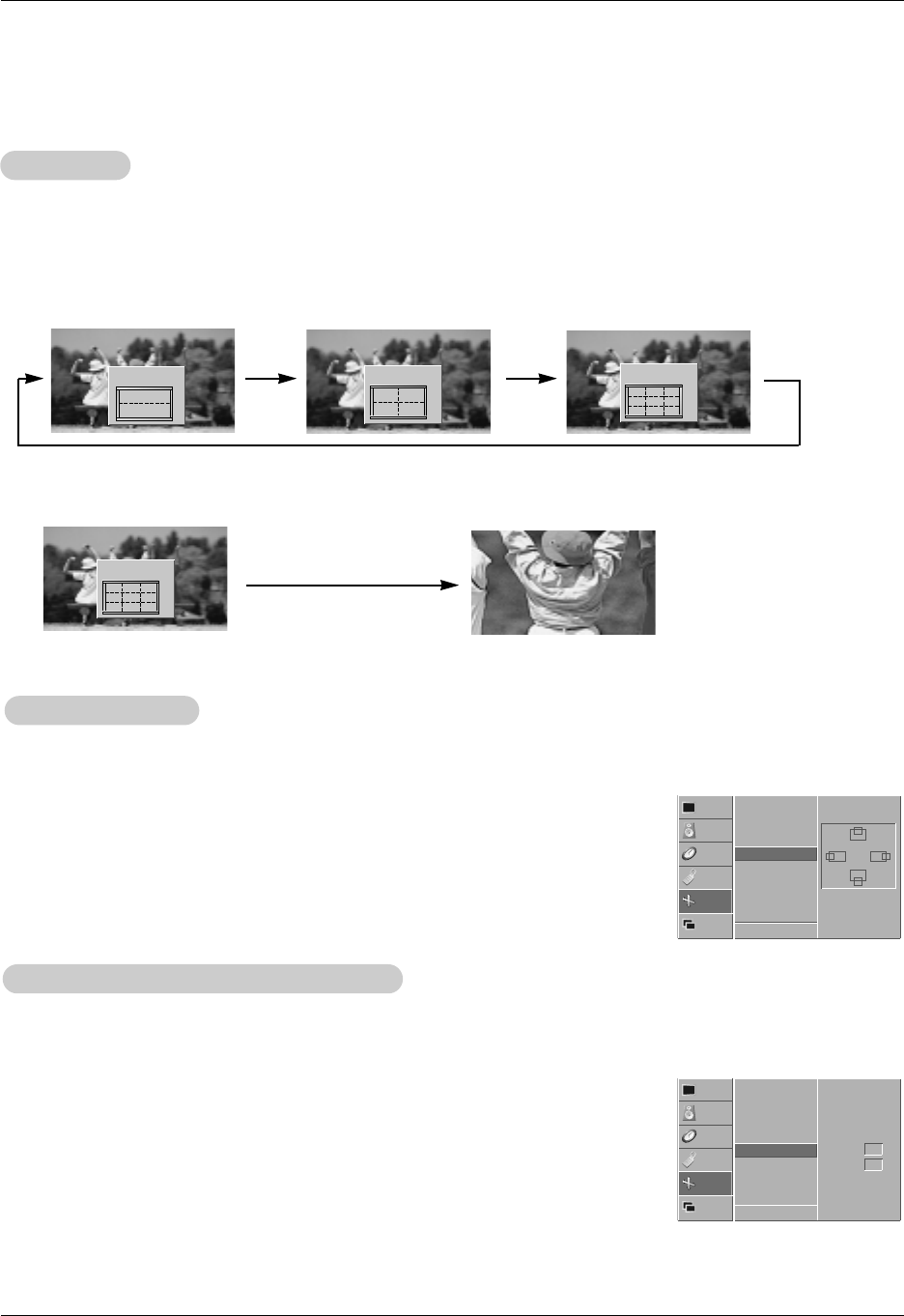
Owner’s Manual 21
Operation
1
4
▲
▼
◀▶
2-Split zoom
▲
▼
◀▶
12
54
4-Split zoom
▲
▼
◀▶
12 3
456
789
9-Split zoom
Manual Configure (RGB-PC mode only)
Manual Configure (RGB-PC mode only)
- If the picture isn’t clear after auto adjustment and especially if characters are still jittery, adjust the picture phase
manually.
- To correct the screen size, adjust Clock.
1. Press the MENU button and then use D / Ebutton to select the SCREEN menu.
2. Press the Gbutton and then use D / Ebutton to select Manual config..
3. Press the Gbutton and then use D / Ebutton to to select Phase or Clock.
4. Use the F / Gbutton to make appropriate adjustments.
• The adjustment range of Phase is 0 ~ 31.
• The adjustment range of Clock is -50 ~ +50.
5. Press the MENU button to save and return to the previous menu.
0
0
VIDEO
AUDIO
TIME
SCREEN
TWIN
SPECIAL
Auto config.
ARC
Zoom in/out
Position
Manual config. G
Screen adj.
Reset
XGA mode
Phase
Clock
MENU Prev.
- This function works in the following mode:
RGB-PC, RGB-DTV (480p,720p,1080i), COMPONENT (480p,720p,1080i).
1. Press the MENU button and then use D / Ebutton to select the SCREEN menu.
2. Press the Gbutton and then use D / Ebutton to select Position.
3. Press the Gbutton and then use D / E/ F / Gbutton to adjust the position.
4. Press the MENU button to save and return to the previous menu.
◀▶
▲
▼
VIDEO
AUDIO
TIME
SCREEN
TWIN
SPECIAL
Auto config.
ARC
Zoom in/out
Position G
Manual config.
Screen adj.
Reset
XGA mode
MENU Prev.
Screen Position
Screen Position
- Enlarges the picture in correct proportion.
- Split Zoom can be used for every input source.
- with 2-SPLIT ZOOM, you can only move the screen into upside or downside.
- If a screen is enlarged, a screen can move without selecting section of screen Split Zoom.
1. Press the SPLIT ZOOM button repeatedly switches between dividing the screen into 2, 4 or 9 sections.
2. Press the number button corresponding to the section you wish to enlarge. you can move the enlarged screen
with using the D / E / F / Gbutton. To return to normal viewing, press the SPLIT ZOOM button again.
Example of choosing 5. Section 5 is enlarged to fill
the screen.
▲
▼
◀▶
12 3
456
789
9-Split zoom
Split Zoom
Split Zoom
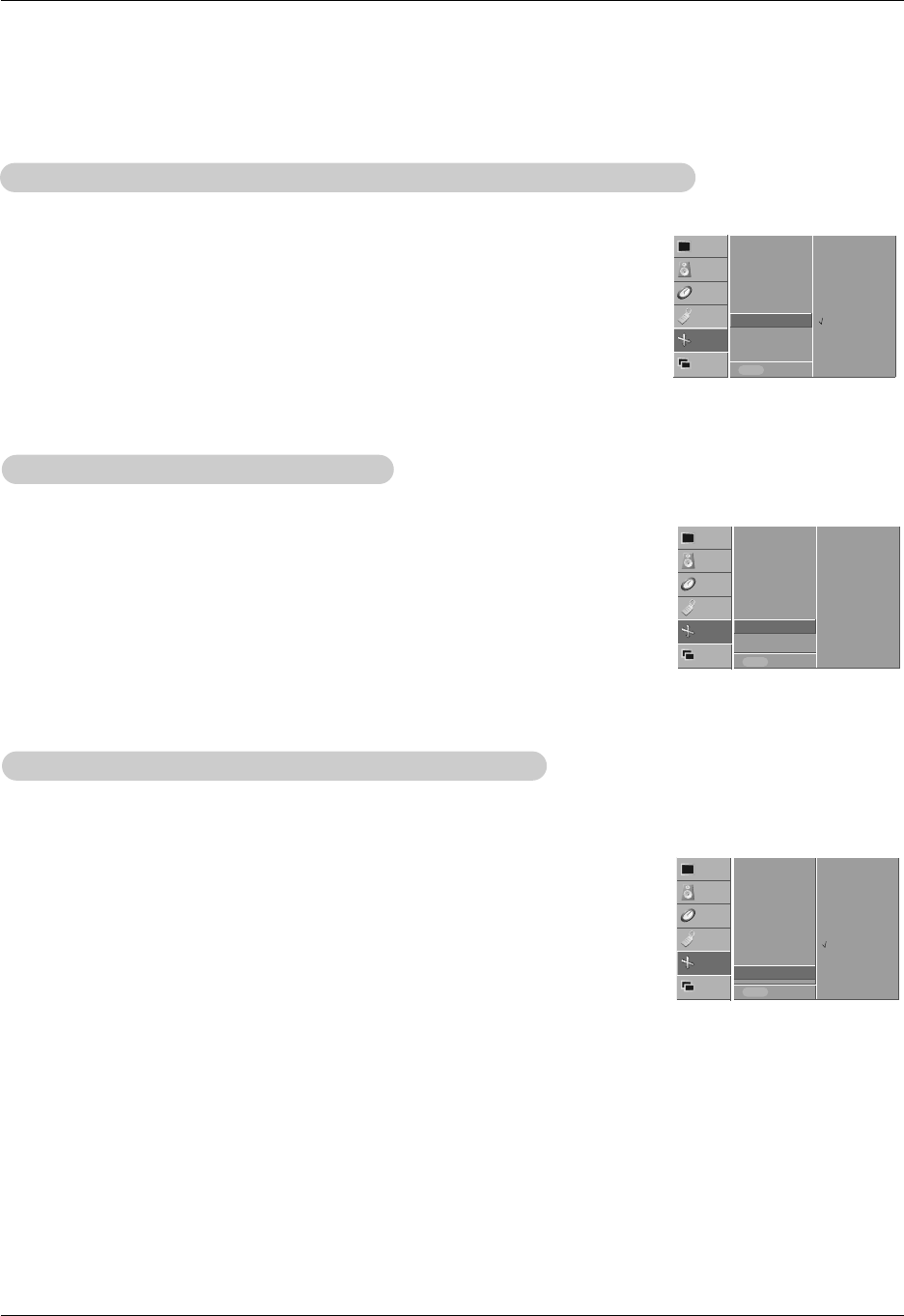
22 Plasma Display
Operation
1. Press the MENU button and then use D / Ebutton to select the SCREEN menu.
2. Press the Gbutton and then use D / Ebutton to select Reset.
3. Press the Gbutton.
•You can initialize POSITION, PIP size, PIP position and sub picture size for twin pic-
ture.
Initializing (Reset to original factory value)
Initializing (Reset to original factory value)
- This function operates in every mode.
- To initialize the adjusted value
VIDEO
AUDIO
TIME
SCREEN
TWIN
SPECIAL
Auto config.
ARC
Zoom in/out
Position
Manual config.
Screen adj.
Reset G
XGA mode
To set
MENU Prev.
1. Press the MENU button and then use D /Ebutton to select the SCREEN menu.
2. Press the Gbutton and then use D /Ebutton to select VGA mode/XGA mode.
3. Press the Gbutton and then use D /Ebutton to select the desired VGA/XGA resolution.
4. Press the MENU button.
Selecting W
Selecting Wide VGA/XGA
ide VGA/XGA mode (RGB, DVI-PC mode only)
mode (RGB, DVI-PC mode only)
- To see a normal picture, match the resolution of RGB XGA mode (1024x768, 1360x768, 1366x768) with the selection for XGA mode
and the resolution of RGB VGA mode (640x480, 848x480, 852x480) with the selection for VGA mode in the SCREEN menu.
- If the input source is RGB VGA mode, the screen menu option is changed from XGA mode to VGA mode automatically.
VIDEO
AUDIO
TIME
SCREEN
TWIN
SPECIAL
Auto config.
ARC
Zoom in/out
Position
Manual config.
Screen adj.
Reset
XGA mode G
1024x768
1360x768
1366x768
MENU Prev.
Screen
Screen Adjustments (V
Adjustments (Video, S-V
ideo, S-Video and Component 480i mode only)
ideo and Component 480i mode only)
- Use this function to correct jittering or picture instability while viewing a video tape.
1. Press the MENU button and then use D /Ebutton to select the SCREEN menu.
2. Press the Gbutton and then use D /Ebutton to select Screen adj..
3. Press the Gbutton and then use D /Ebutton to to select TV or VCR.
• Select the VCR option if watching a VCR.
• Select the TV option for other equipment.(Except VCR)
4. Press the MENU button.
VIDEO
AUDIO
TIME
SCREEN
TWIN
SPECIAL
Auto config.
ARC
Zoom in/out
Position
Manual config.
Screen adj. G
Reset
XGA mode
TV
VCR
MENU Prev.
Screen Menu Options continued
Screen Menu Options continued
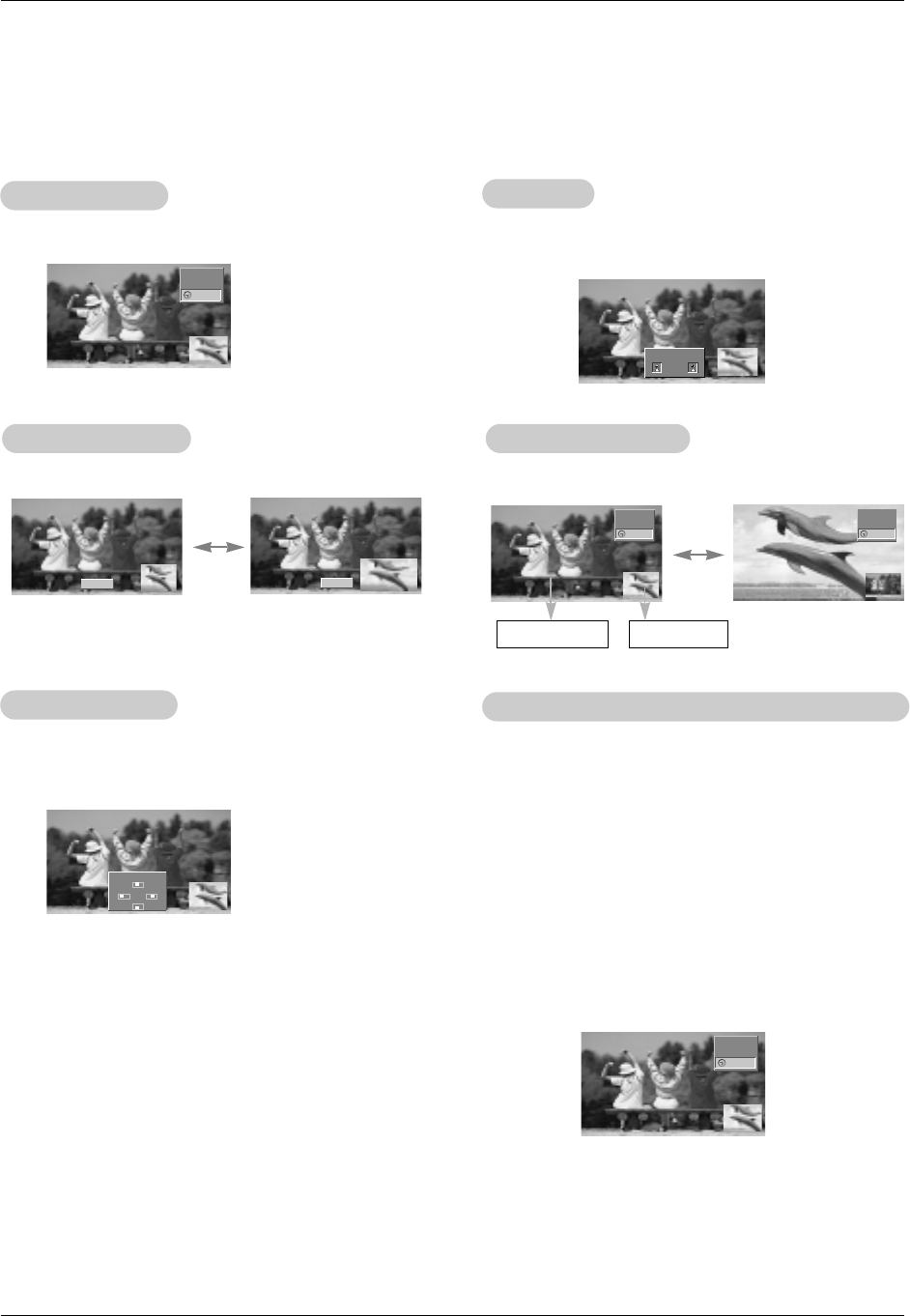
Owner’s Manual 23
Operation
W
Watching PIP
atching PIP
- PIP lets you view 2 different inputs (sources) on your monitor screen at the same time. One source will be large, and the
other source will show a smaller inset image.
- When you select PC or DTV for main picture in PIP, you can watch VIDEO, S-VIDEO or COMPONENT 480i for sub picture.
Press the PIP button repeatedly to select turn PIP on or off.
PIP
PIP Size
Size
Press the WIN.SIZE button and then use F / Gbutton to
change the sub picture size.
PIP
PIP Aspect Ratio
Aspect Ratio
Press the PIP ARC button. The sub picture appears as shown.
Moving the PIP
Moving the PIP
Press the WIN.POSITION button.
Press the D / E/ F / Gbutton repeatedly until desired posi-
tion is achieved. The sub picture moves up/down/left/right.
Swapping the PIP
Swapping the PIP
Press the SWAP button to exchange the main and sub pictures.
Selecting a Input Signal Source for the PIP
Selecting a Input Signal Source for the PIP
Use the SUB INPUT button to select the input source for
the sub picture.
•In Video for main picture, you can select S-Video,
Component 480p/720p/1080i, RGB and DVI for sub pic-
ture.
•In S-Video for main picture, you can select Video,
Component 480p/720p/1080i, RGB and DVI for sub pic-
ture.
•In Component 480i for main picture, you can select RGB,
DVI, Video and S-Video for sub picture.
•In Component 480p/720p/1080i for main picture, you can
select Video and S-Video for sub picture.
•In RGB and DVI for main picture, you can select
Component 480i, Video and S-Video for sub picture.
Main Picture Sub Picture
◀▶
▲
▼
10 : 30 10 : 30
10 : 30
4 : 3 16 : 9
Win.position
Component
Video
Component
Video
Video
Component
PIP
PIP (Picture-In-Picture) Feature
(Picture-In-Picture) Feature
10 : 30
Component
Video
Win.size
F G
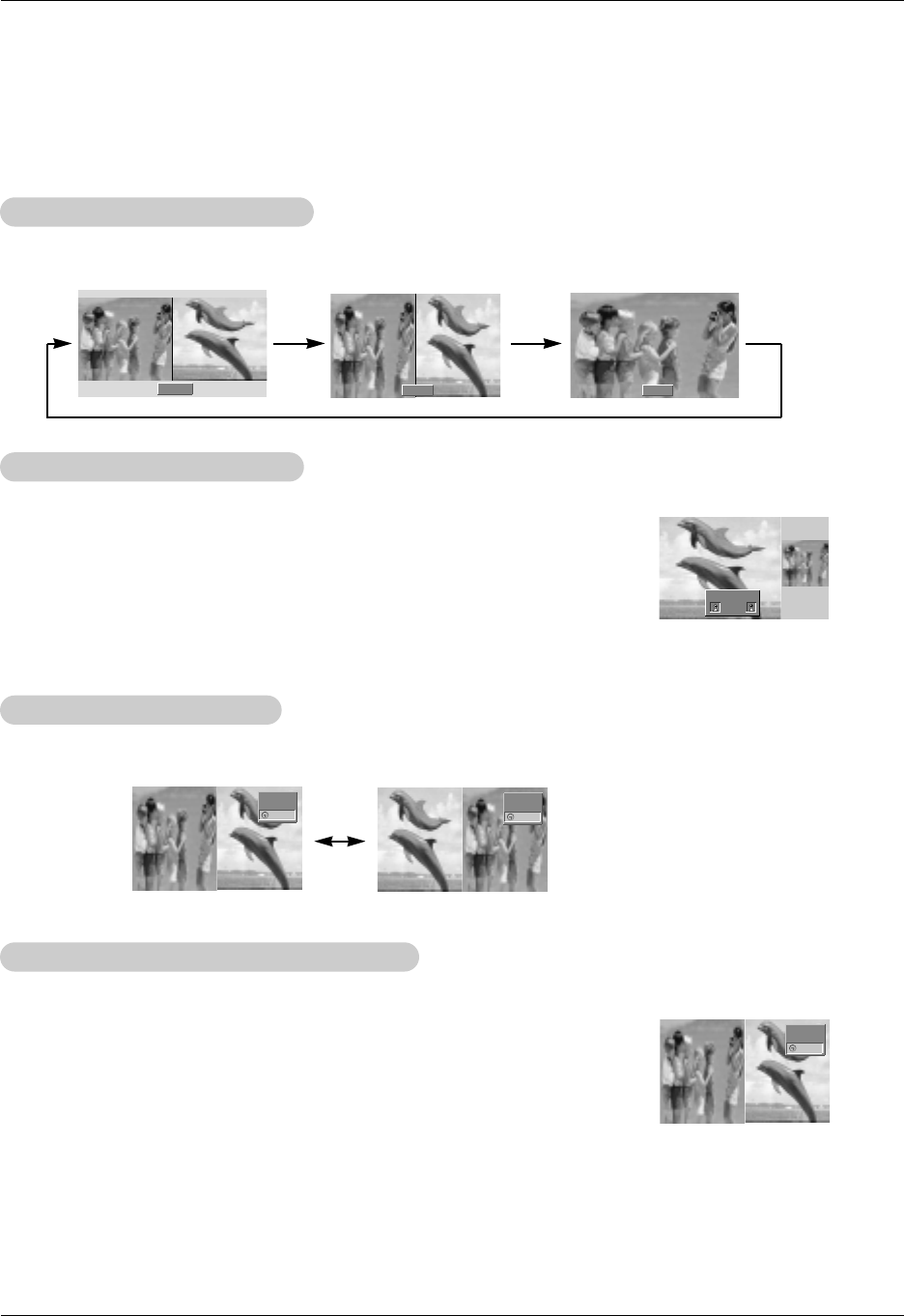
24 Plasma Display
Operation
Selecting a Source for the
Selecting a Source for the T
Twin Picture
win Picture
Use the SUB INPUT button to select the input source for the sub picture.
•In Video for main picture, you can select S-Video, Component 480p/720p/1080i, RGB
and DVI for sub picture.
•In S-Video for main picture, you can select Video, Component 480p/720p/1080i, RGB
and DVI for sub picture.
•In Component 480i for main picture, you can select RGB, DVI, Video and S-Video for
sub picture.
•In Component 480p/720p/1080i for main picture, you can select Video and S-Video for
sub picture.
•In RGB and DVI for main picture, you can select Component 480i, Video and S-Video
for sub picture.
Main Picture Size
Main Picture Size Adjustment
Adjustment
Use the TWIN PICTURE button repeatedly to select one of the Twin Picture options.
Sub Picture Size
Sub Picture Size Adjustment
Adjustment
Use the WIN.SIZE button.
•Use the F / Gbutton to adjust the sub picture size.
•Using WIN.SIZE function in Twin Picture mode, main and sub picture are adjusted
simultaneously.
Using WIN.SIZE function in PIP mode, sub picture is adjusted.
•WIN.POSITION is not functional in twin picture mode.
Swapping the
Swapping the T
Twin Picture
win Picture
Use the SWAP button to switch the main and sub pictures in twin picture mode.
DW 1
DW 2
10 : 30
10 : 30
10 : 30
◀▶
Off
COMPONENT
VIDEO
Component
Video Video
Component
- As the name suggests, this mode splits the screen into 2, allowing 2 picture sources to be shown on the monitor screen at the
same time. Each source is given half the screen.
T
Twin Picture Setup Option
win Picture Setup Option
Win.size
F G

Owner’s Manual 25
External Control Device Setup
Set ID
Set ID
- Use this function to specify a monitor ID number.
- Refer to ‘Real Data Mapping 1’. See page 27.
1. Press the MENU button and then use the D /Ebutton to select the SPECIAL menu.
2. Press the Gbutton and then use D /Ebutton to select Set id..
3. Press the Gbutton and then use F / Gbutton to adjust Set id. to choose the desired
monitor ID number.
• The adjustment range of Set id. is 1 ~ 99.
1
VIDEO
AUDIO
TIME
SCREEN
TWIN
SPECIAL
language
Key lock
ISM method
Low power
Set id. G
OSD rotate
MENU Prev.
No. Pin name
1 No connection
2 RXD (Receive data)
3 TXD (Transmit data)
4 DTR (DTE side ready)
5 GND
6 DSR (DCE side ready)
7 RTS (Ready to send)
8 CTS (Clear to send)
9 No Connection
1
5
6
9
2
3
5
4
6
7
8
RXD
TXD
GND
DTR
DSR
RTS
CTS
TXD
RXD
GND
DSR
DTR
CTS
RTS
PC
7-wire configuration
(Standard RS-232C cable)
D-Sub 9
3
2
5
6
4
8
7
PDP
D-Sub 9
2
3
5
4
6
7
8
RXD
TXD
GND
DTR
DSR
RTS
CTS
TXD
RXD
GND
DTR
DSR
RTS
CTS
PC
3-wire configuration
(Not standard)
D-Sub 9
3
2
5
4
6
7
8
PDP
D-Sub 9
- Connect the RS-232C input jack to an external control device (such as a computer or an A/V control system)
and control the Monitor’s functions externally.
- Connect the serial port of the control device to the RS-232C jack on the Monitor back panel.
- RS-232C connection cables are not supplied with the Monitor.
T
Type of connector; D-Sub 9-pin male
ype of connector; D-Sub 9-pin male
RS-232C configurations
RS-232C configurations
• Baud rate : 115200 bps (UART)
• Data length : 8 bits
• Parity : None
• Stop bit : 1 bit
• Communication code : ASCII code
Communication Parameters
Communication Parameters
External Control Device Setup
External Control Device Setup

26 Plasma Display
External Control Device Setup
Transmission
* [Command 1] : k
* [Command 2] : To control PDP set.
* [Set ID] : You can adjust the set ID to choose
desired monitor ID number in special
menu. See previous page.
Adjustment range is 1 ~ 99.
When selecting Set ID ‘0’, every
connected PDP set is controlled.
* [DATA] : To transmit command data.
Transmit ‘FF’data to read status of
command.
* [Cr] : Carriage Return
ASCII code ‘0x0D’
* [ ] : ASCII code ‘space (0x20)’
[Command1][Command2][ ][Set ID][ ][Data][Cr]
OK Acknowledgement
* The Monitor transmits ACK (acknowledgement) based on
this format when receiving normal data. At this time, if the
data is data read mode, it indicates present status data. If
the data is data write mode, it returns the data of the PC
computer.
[Command2][ ][Set ID][ ][OK][Data][x]
Error Acknowledgement
* The Monitor transmits ACK (acknowledgement) based on
this format when receiving abnormal data from
non-viable functions or communication errors.
[Command2][ ][Set ID][ ][NG][x]
T
Transmission / Receiving Protocol
ransmission / Receiving Protocol 02. Input Select (Command:b) (Main Picture Input)
GTo select input source for the Monitor.
You can also select an input source using the INPUT
SELECT button on the Monitor's remote control.
Transmission
Data 0 : RGB 1
1 : COMPONENT
2 : VIDEO
3 : S-VIDEO
4 : RGB 2
[k][b][ ][Set ID][ ][Data][Cr]
Acknowledgement
[b][ ][Set ID][ ][OK][Data][x]
01. Power (Command:a)
GTo control Power On/Off of the Monitor.
Transmission
Data 0 : Power Off 1 : Power On
[k][a][ ][Set ID][ ][Data][Cr]
Acknowledgement
[a][ ][Set ID][ ][OK][Data][x]
GTo show Power On/Off.
Transmission
[k][a][ ][Set ID][ ][FF][Cr]
Acknowledgement
Data 0 : Power Off 1 : Power On
* In like manner, if other functions transmit ‘FF’data based
on this format, Acknowledgement data feed back presents
status about each function.
[a][ ][Set ID][ ][OK][Data][x]
01. Power k a 0 ~ 1
02. Input Select k b 0 ~ 4
03. Aspect Ratio k c 0 ~ 2
04. Screen Mute k d 0 ~ 1
05. Volume Mute k e 0 ~ 1
06. Volume Control k f 0 ~ 64
07. Contrast k g 0 ~ 64
08. Brightness k h 0 ~ 64
09. Color k i 0 ~ 64
10. Tint k j 0 ~ 64
11. Sharpness k k 0 ~ 64
12. OSD select k l 0 ~ 1
13.
Remote control lock mode
k m 0 ~ 1
14. PIP/Twin k n 0 ~ 3
15. PIP size k o 0 ~ 1
16. PIP position k q 0 ~ 3
17. Treble k r 0 ~ 64
18. Bass k s 0 ~ 64
19. Balance k t 0 ~ 64
20. Color temperature k u 0 ~ 3
21. Red adjustment k v 0 ~ 64
22. Green adjustment k w 0 ~ 64
23. Blue adjustment k $ 0 ~ 64
24. PIP input source k y 0 ~ 4
25. Abnormal Status k z 0 ~ a
26. Orbiter j p 0 ~ 1
27. White Wash j q 0 ~ 1
28. Orbiter Time Setting j r 1 ~ FE
29. Orbiter Pixel Setting j s 0 ~9
30. Picture Size Setting j t 0 ~64
for Twin Picture mode
COMMAND 1 COMMAND 2 DATA
(Hexadecimal)
•When setting the 26 ~ 30, a menu doesn’t display on
screen.
Command Reference List
Command Reference List
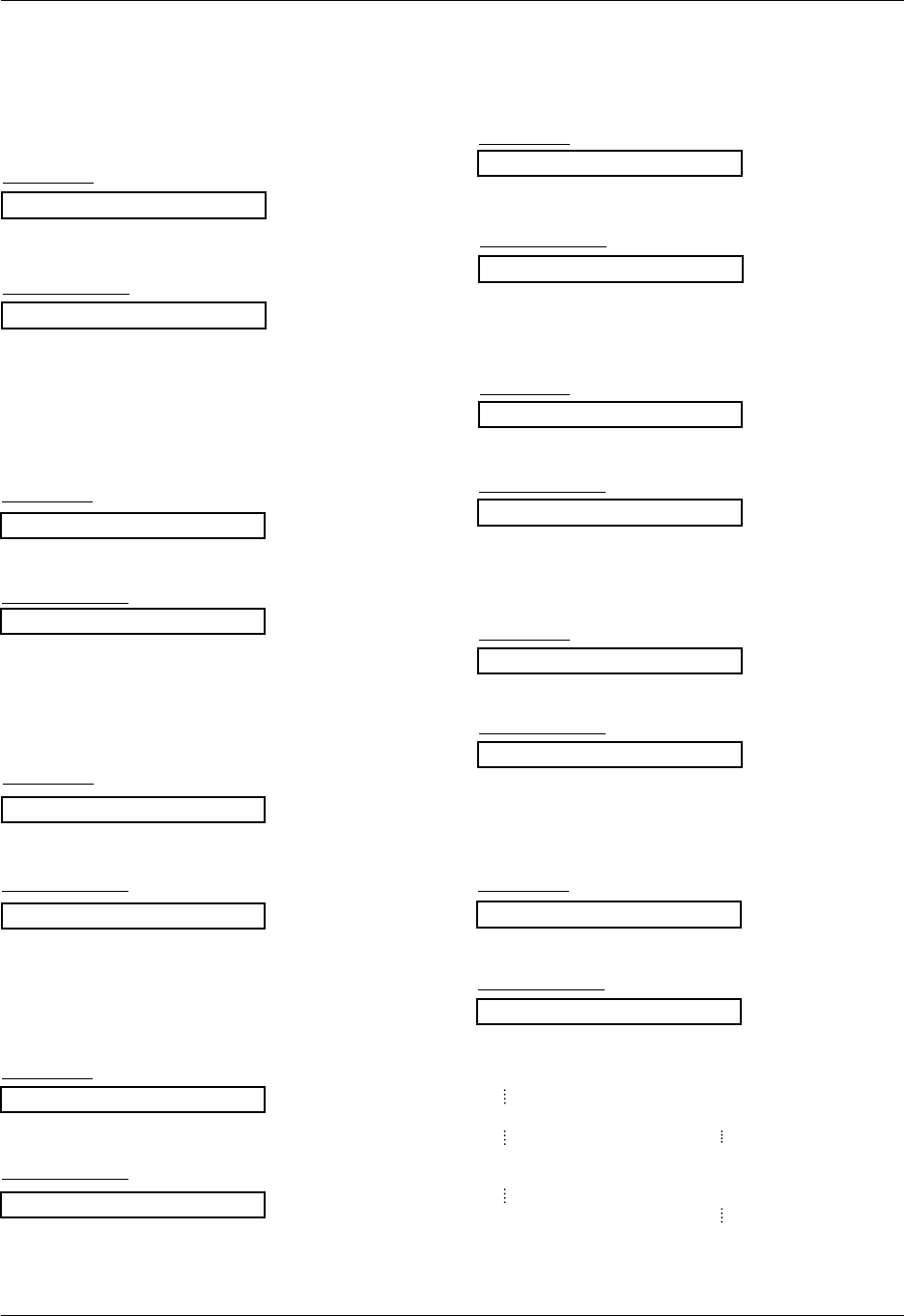
Owner’s Manual 27
External Control Device Setup
09. Color (Command:i)
GTo adjust the screen color.
You can also adjust color in the Video menu.
Transmission
Data Min : 0 ~ Max : 64
* Refer to ‘Real data mapping1’as shown below.
[k][i][ ][Set ID][ ][Data][Cr]
Acknowledgement
[i][ ][Set ID][ ][OK][Data][x]
10. Tint (Command:j)
GTo adjust the screen tint.
You can also adjust tint in the Video menu.
Transmission
Data Red : 0 ~ Green : 64
* Refer to ‘Real data mapping1’as shown below.
[k][j][ ][Set ID][ ][Data][Cr]
Acknowledgement
[j][ ][Set ID][ ][OK][Data][x]
* Real data mapping 1
0 : Step 0
A : Step 10 (SET ID 10)
F : Step 15 (SET ID 15)
10 : Step 16 (SET ID 16)
64 : Step 100
* Real data mapping 2
0 : -10
5: -9
A: -8
2D: -1
32: 0
37: +1
5F: +9
64: +10
08. Brightness (Command:h)
GTo adjust screen brightness.
You can also adjust brightness in the Video menu.
Transmission
Data Min : 0 ~ Max : 64
* Refer to ‘Real data mapping1’as shown below.
[k][h][ ][Set ID][ ][Data][Cr]
Acknowledgement
[h][ ][Set ID][ ][OK][Data][x]
05. Volume Mute (Command:e)
GTo control volume mute on/off.
You can also adjust mute using the MUTE button on
remote control.
Transmission
Data 0 : Volume mute on (Volume off)
1 : Volume mute off (Volume on)
[k][e][ ][Set ID][ ][Data][Cr]
Acknowledgement
[e][ ][Set ID][ ][OK][Data][x]
03. Aspect Ratio (Command:c) (Main picture format)
GTo adjust the screen format.
You can also adjust the screen format using the ARC
(Aspect Ratio Control) button on remote control or in the
Special menu.
Transmission
Data 0 : Wide screen (16:9)
1 : Normal screen (4:3)
2 : Full screen (Zoom)
[k][c][ ][Set ID][ ][Data][Cr]
Acknowledgement
* Using the PC input, you select either 16:9 or 4:3 screen
aspect ratio.
[c][ ][Set ID][ ][OK][Data][x]
04. Screen Mute (Command:d)
GTo select screen mute on/off.
Transmission
Data 0 : Screen mute off (Picture on)
1 : Screen mute on (Picture off)
[k][d][ ][Set ID][ ][Data][Cr]
Acknowledgement
[d][ ][Set ID][ ][OK][Data][x]
06. Volume Control (Command:f)
GTo adjust volume.
You can also adjust volume with the volume buttons
on remote control.
Transmission
Data Min : 0 ~ Max : 64
* Refer to ‘Real data mapping1’as shown right.
[k][f][ ][Set ID][ ][Data][Cr]
Acknowledgement
[f][ ][Set ID][ ][OK][Data][x]
07. Contrast (Command:g)
GTo adjust screen contrast.
You can also adjust contrast in the Video menu.
Transmission
Data Min : 0 ~ Max : 64
* Refer to ‘Real data mapping1’as shown below.
[k][g][ ][Set ID][ ][Data][Cr]
Acknowledgement
[g][ ][Set ID][ ][OK][Data][x]
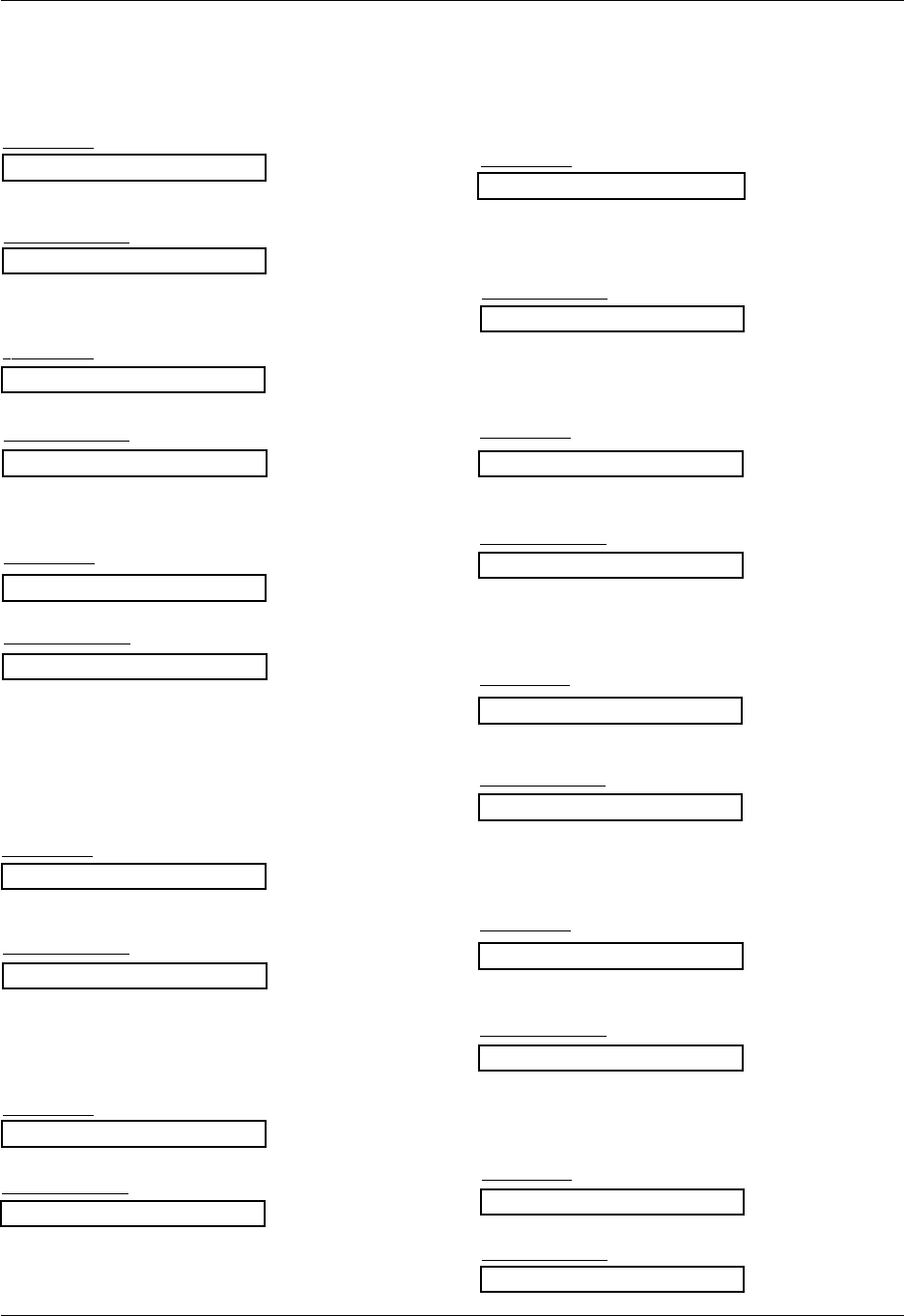
28 Plasma Display
External Control Device Setup
20. Color Temperature (Command2:u)
GTo adjust color temperature.
You can also adjust ACC in the Video menu.
Transmission
Data 0: Normal 1: Cool 2: Warm 3: User
[k][u][ ][Set ID][ ][Data][Cr]
Acknowledgement
[u][ ][Set ID][ ][OK][Data][x]
17. Treble (Command2:r)
GTo adjust treble.
You can also adjust treble in the Audio menu.
Transmission
Data Min: 0 ~ Max: 64
•Refer to ‘Real data mapping1’. See page 27.
[k][r][ ][Set ID][ ][Data][Cr]
Acknowledgement
[r][ ][Set ID][ ][OK][Data][x]
16. PIP Position (Command2:q)
GTo select sub picture position for PIP.
You can also adjust the sub picture position using
WIN.POSITION on the remote control or in the Special menu.
Transmission
Data 0: Right down on screen
1: Left down on screen
2: Left up on screen
3: Right up on screen
[k][q][ ][Set ID][ ][Data][Cr]
Acknowledgement
[q][ ][Set ID][ ][OK][Data][x]
18. Bass (Command2:s)
GTo adjust bass.
You can also adjust bass in the Audio menu.
Transmission
Data Min: 0 ~ Max: 64
•Refer to ‘Real data mapping1’. See page 27.
[k][s][ ][Set ID][ ][Data][Cr]
Acknowledgement
[s][ ][Set ID][ ][OK][Data][x]
19. Balance (Command2:t)
GTo adjust balance.
You can also adjust balance in the Audio menu.
Transmission
Data Min: 0 ~ Max: 64
•Refer to ‘Real data mapping1’. See page 27.
[k][t][ ][Set ID][ ][Data][Cr]
Acknowledgement
[t][ ][Set ID][ ][OK][Data][x]
13. Remote Control Lock Mode (Command2:m)
GTo lock the front panel controls on the monitor
Transmission
[k][m][ ][Set ID][ ][Data][Cr]
Acknowledgement
Data 0: Lock off 1: Lock on
•If you’re not using the remote control, use this mode.
When main power is on/off, remote control lock is released.
[m][ ][Set ID][ ][OK][Data][x]
14. PIP / Twin (Command2:n)
GTo control the PIP (Picture In picture).
You can also control the PIP/TWIN using the PIP or Twin
picture button on the remote control or in the Special menu.
Transmission
Data 0: PIP/DW off
1: PIP 2: DW1
3: DW2
[k][n][ ][Set ID][ ][Data][Cr]
Acknowledgement
[n][ ][Set ID][ ][OK][Data][x]
GTo adjust the screen sharpness.
You can also adjust sharpness in the Video menu.
Transmission
11. Sharpness (Command2:k)
Data Min: 0 ~ Max: 64
•Refer to ‘Real data mapping1’. See page 27.
[k][k][ ][Set ID][ ][Data][Cr]
Acknowledgement
[k][ ][Set ID][ ][OK][Data][x]
12. OSD Select (Command2:l)
GTo select OSD (On Screen Display) on/off.
Transmission
[k][l][ ][Set ID][ ][Data][Cr]
Acknowledgement
Data 0: OSD off 1: OSD on
[l][ ][Set ID][ ][OK][Data][x]
15. PIP Size (Command2:o)
GTo select the PIP picture format.
You can also select the PIP picture format using WIN.SIZE
on the remote control.
Transmission
[k][o][ ][Set ID][ ][Data][Cr]
Acknowledgement
Data 0: 4:3 1: 16:9
[o][ ][Set ID][ ][OK][Data][x]
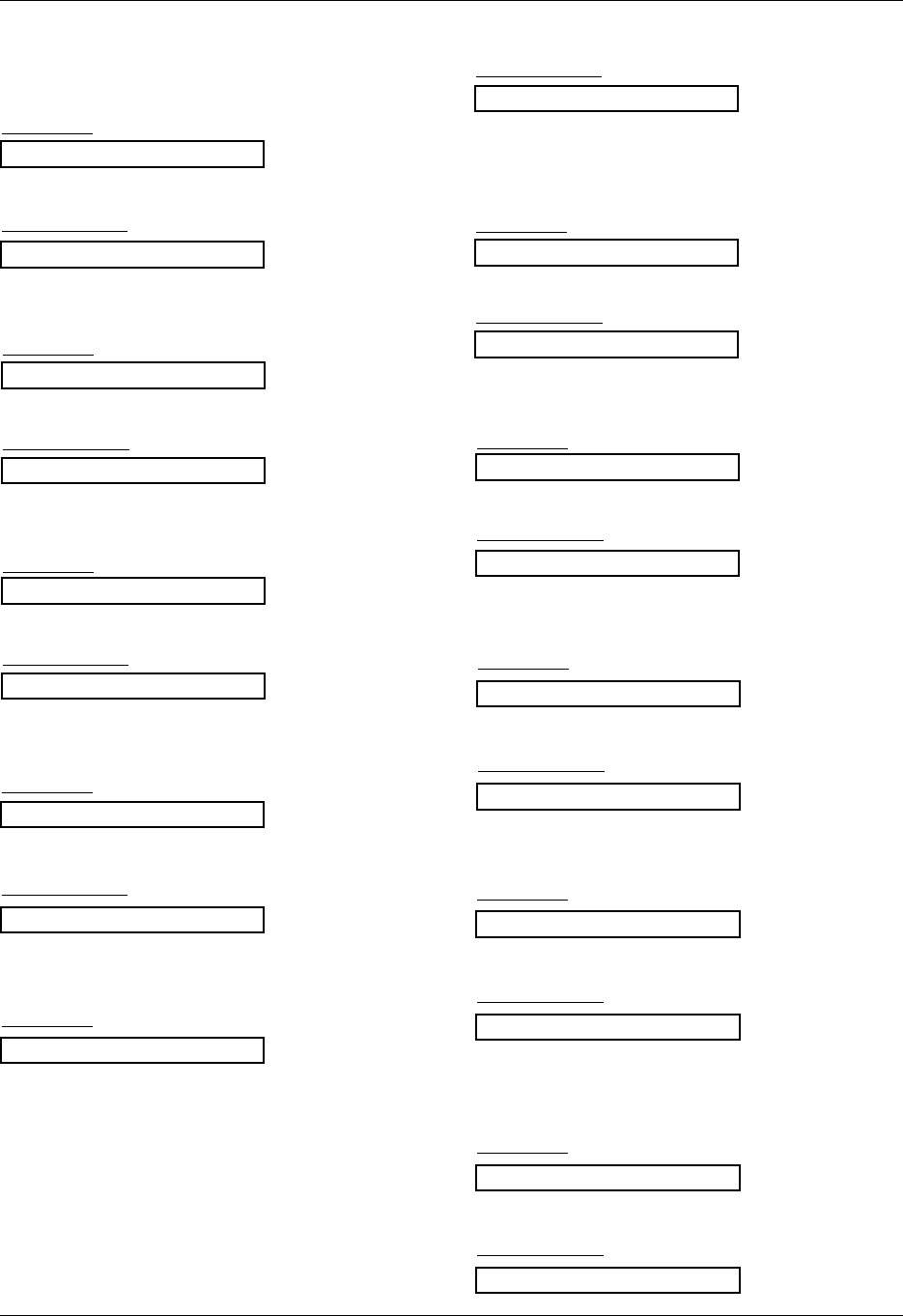
Owner’s Manual 29
External Control Device Setup
26. Orbiter (Command2:p)
GTo control the orbiter function on/off.
Transmission
Data 0: Orbiter off
1: Orbiter on
[j][p][ ][Set ID][ ][Data][Cr]
Acknowledgement
[p][ ][Set ID][ ][OK][Data][x]
27. White Wash (Command2:q)
GTo control the white wash function on/off.
Transmission
Data 0: White Wash off
1: White Wash on
[j][q][ ][Set ID][ ][Data][Cr]
Acknowledgement
[q][ ][Set ID][ ][OK][Data][x]
28. Orbiter Time Setting (Command2:r)
GTo adjust orbiter operation time term.
Transmission
Data Min: 1 ~ Max: FE
•Refer to ‘Real data mapping1’. See page 27.
[j][r][ ][Set ID][ ][Data][Cr]
Acknowledgement
[r][ ][Set ID][ ][OK][Data][x]
29. Orbiter Pixel Setting (Command2:s)
GTo adjust pixel number in orbiter function.
Transmission
Data Min: 0 ~ Max: 9
•Refer to ‘Real data mapping1’. See page 27.
[j][s][ ][Set ID][ ][Data][Cr]
Acknowledgement
[s][ ][Set ID][ ][OK][Data][x]
30. Picture Size Setting for Twin Picture mode
(Command2:t)
GTo adjust main window size in twin picture mode.
Transmission
Data Min: 0 ~ Max: 64
•Refer to ‘Real data mapping1’. See page 27.
[j][t][ ][Set ID][ ][Data][Cr]
Acknowledgement
[t][ ][Set ID][ ][OK][Data][x]
21. Red Adjustment (Command2:v)
GTo adjust red in color temperature.
Transmission
Data Min: 0 ~ Max: 64
•Refer to ‘Real data mapping 2’. See page 27.
[k][v][ ][Set ID][ ][Data][Cr]
Acknowledgement
[v][ ][Set ID][ ][OK][Data][x]
22. Green Adjustment (Command2:w)
GTo adjust green in color temperature.
Transmission
Data Min: 0 ~ Max: 64
•Refer to ‘Real data mapping 2’. See page 27.
[k][w][ ][Set ID][ ][Data][Cr]
Acknowledgement
[w][ ][Set ID][ ][OK][Data][x]
23. Blue Adjustment (Command2:$)
GTo adjust blue in color temperature.
Transmission
Data Min: 0 ~ Max: 64
•Refer to ‘Real data mapping 2’. See page 27.
[k][$][ ][Set ID][ ][Data][Cr]
Acknowledgement
[$][ ][Set ID][ ][OK][Data][x]
24. PIP Input Select (Command2:y)
G To select input source for sub picture in PIP mode.
Transmission
Data 0: RGB1 1: COMPONENT
2: VIDEO 3: S-VIDEO 4: RGB2
[k][y][ ][Set ID][ ][Data][Cr]
Acknowledgement
[y][ ][Set ID][ ][OK][Data][x]
25. Abnormal State (Command2:z)
GTo recognize an abnormal state.
Transmission
Data 0: Normal (Power on and signal exist)
1: No signal (Power on)
2: Turn the monitor off by remote control
3: Turn the monitor off by sleep time function
4: Turn the monitor off by RS-232C function
5: 5V down
6: AC down
7: Turn the monitor off by Fan Alarm function
8: Turn the monitor off by off time function
9: Turn the monitor off by auto off function
a: Turn the monitor off by AV board detect
* This function is “read only”.
[k][z][ ][Set ID][ ][FF][Cr]
Acknowledgement
[z][ ][Set ID][ ][OK][Data][x]
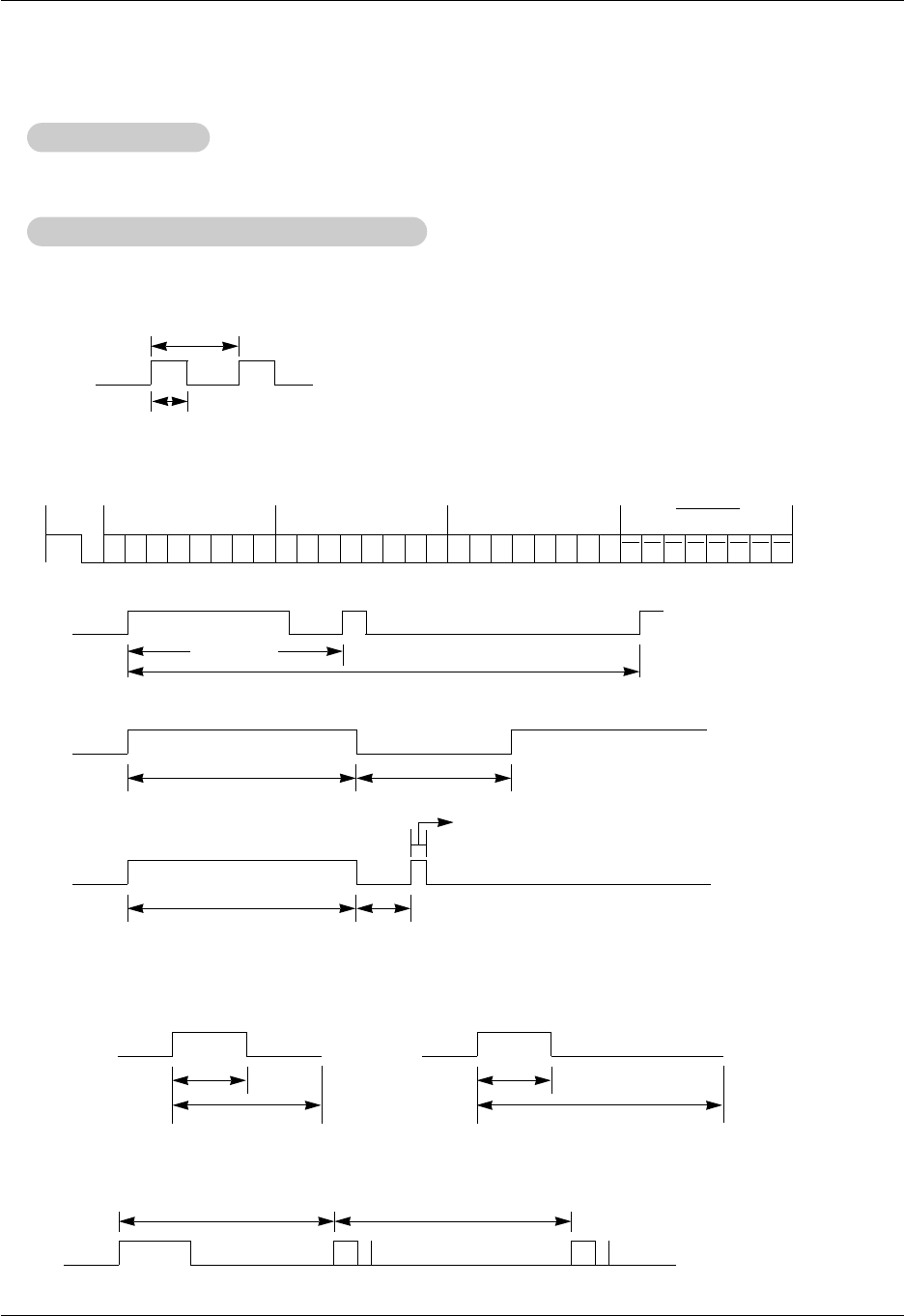
30 Plasma Display
IR Code
G Connect your wired remote control to the Remote port on the Monitor.
Set the CONTROL LOCK to ‘ON’on the Monitor back panel to operate Monitor with wired remote control.
G Output waveform
Single pulse, modulated with 37.917KHz signal at 455KHz
G Configuration of frame
G Repeat code
G Lead code
• 1st frame
Low
custom code
Lead
code High
custom code Data code Data code
TC
Tf
T1
C0
Carrier frequency
FCAR = 1/TC= fOSC/12
Duty ratio = T1/TC= 1/3
• Repeat frame
C1 C2 C3 C4 C5 C6 C7 C0 C1 C2 C3 C4 C5 C6 C7 D0 D1 D2 D3 D4 D5 D6 D7 D0 D1 D2 D3 D4 D5 D6 D7
Repeat code
9 ms 4.5 ms
0.55 ms
9 ms
2.25 ms
G Bit description
G Frame interval : Tf
The waveform is transmitted as long as a key is depressed.
• Bit “0”
Tf Tf
Tf=108ms @455KHz
0.56 ms 0.56 ms
1.12 ms
• Bit “1”
2.24 ms
How to connect
How to connect
Remote Control IR Code (NEC Format)
Remote Control IR Code (NEC Format)
IR Code (NEC Format)
IR Code (NEC Format)

Owner’s Manual 31
IR Code
UP (D)
DOWN (E)
VOL+ (G)
VOL- (F)
POWER On/Off
POWER ON
POWER OFF
MUTE
Number Key 0
Number Key 1
Number Key 2
Number Key 3
Number Key 4
Number Key 5
Number Key 6
Number Key 7
Number Key 8
Number Key 9
AII INPUT SELECT
RGB 1
RGB 2 (DVI input)
VIDEO
S-VIDEO
COMPONENT
SLEEP
OK (Á)
MENU
DASP
APC
PIP
PIP INPUT
SWAP
PIP ARC
TWIN PICTURE
ZOOM +
ZOOM -
Window Size
Window Position
Split Zoom
ARC
ARC (4:3)
ARC (16:9)
ARC (ZOOM)
00H
01H
02H
03H
08H
C4H
C5H
09H
10H
11H
12H
13H
14H
15H
16H
17H
18H
19H
0BH
98H
C6H
5AH
51H
BFH
0EH
44H
43H
52H
4DH
60H
61H
63H
64H
6BH
40H
41H
69H
6AH
7BH
79H
76H
77H
AFH
R/C Button
R/C Button
R/C Button
R/C Button
R/C Button (Power On/Off)
Discrete IR Code (Only Power On)
Discrete IR Code (Only Power Off)
R/C Button
R/C Button
R/C Button
R/C Button
R/C Button
R/C Button
R/C Button
R/C Button
R/C Button
R/C Button
R/C Button
R/C Button(RGB1/RGB2/Comp/VIDEO/S-VIDEO)
Discrete IR Code (Input RGB1 Selection)
Discrete (Input RGB2 Selection)
Discrete (Input VIDEO Selection)
Discrete (Input S-VIDEO Selection)
Discrete (Input COMPONENT Selection)
R/C Button
R/C Button
R/C Button
R/C Button
R/C Button
R/C Button
R/C Button
R/C Button (PIP/TWIN Exchange)
R/C Button (4:3/16:9)
R/C Button
R/C Button
R/C Button
R/C Button
R/C Button
R/C Button
R/C Button(4:3/16:9/Zoom Mode Selection)
Discrete (Only 4:3 mode)
Discrete (Only 16:9 mode)
Discrete (Only ZOOM mode)
Code (Hexa) Function Note
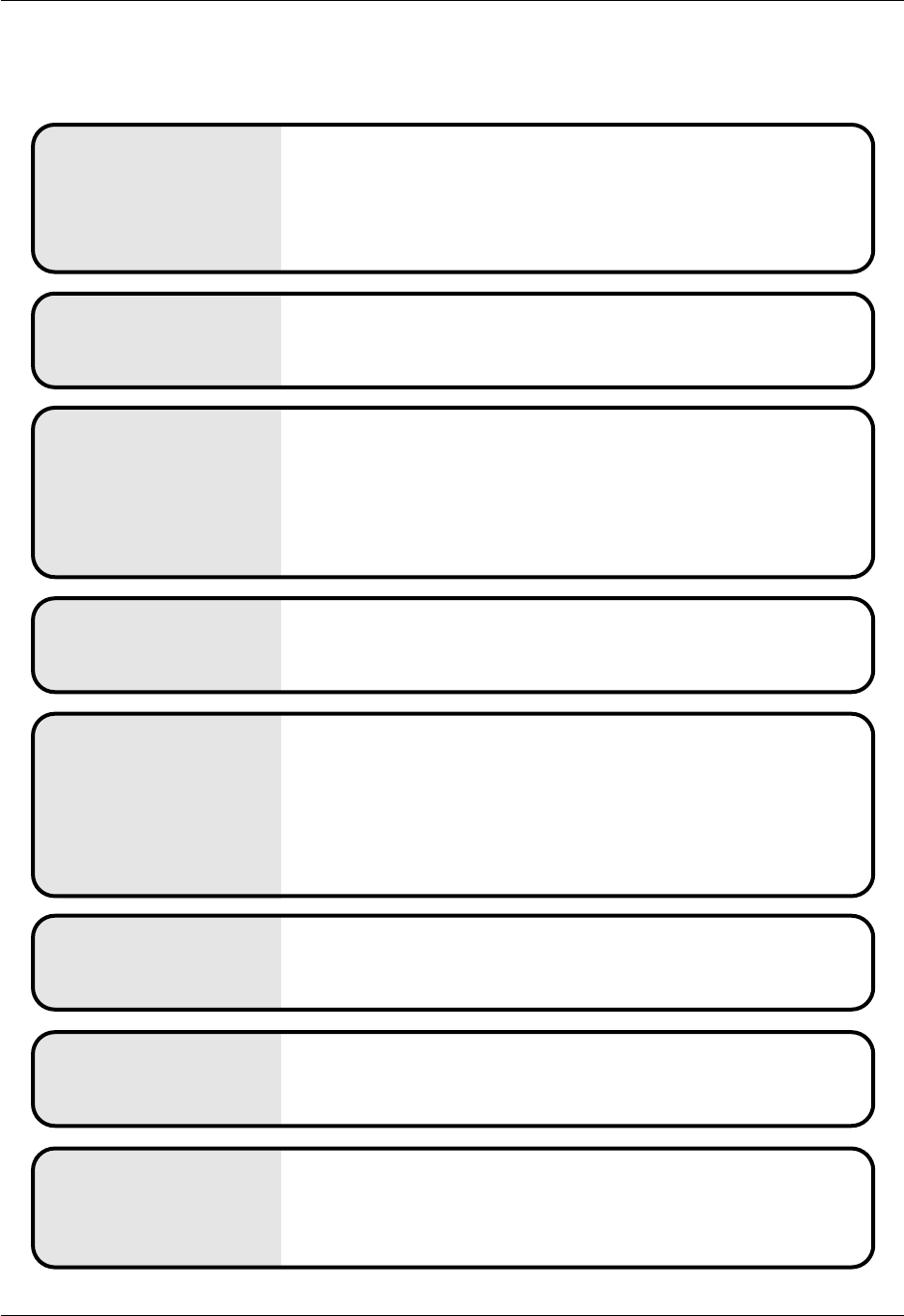
32 Plasma Display
Troubleshooting Checklist
No output from one of
the speakers •Adjust Balance in the AUDIO menu. (Refer to p.17)
Unusual sound from
inside the monitor
•A change in ambient humidity or temperature may result in an unusual noise
at the time of switching off or on of the monitor and does not indicate a fault
with the monitor.
No picture &
No sound
•Check whether the Monitor is turned on.
•Power cord inserted into wall outlet?
•Test the wall power outlet, plug other product’s power cord into the wall outlet
where the Monitor’s power cord was plugged in.
No or Poor color
or Poor picture
•Select Color in the VIDEO menu and press the VOLUME (G) button.
(Refer to p.16)
•Keep a certain distance between the Monitor and the VCR.
•Activate any function to restore the brightness of the picture.
(If still picture is on the screen for more than 5 minutes, the screen gets dark.)
The remote control
doesn’t work
•Check to see if there is any object between the Plasma Display and the
remote control causing obstruction.
•Are batteries installed with correct polarity (+ to +, - to -)?
(Refer to p.8)
•Install new batteries. (Refer to p.8)
Picture OK &
No sound
•Press the VOLUME (G) button.
•Sound muted? Press MUTE button.
Picture appears slowly,
after switching on
•This is normal as the image is muted during the startup process of the moni-
tor. Please contact your service centre,if the picture has not appeared after
five minutes.
Horizontal/vertical bars
or picture shaking •Check for local interference such as an electrical appliance or power tool.
T
Troubleshooting Checklist
roubleshooting Checklist
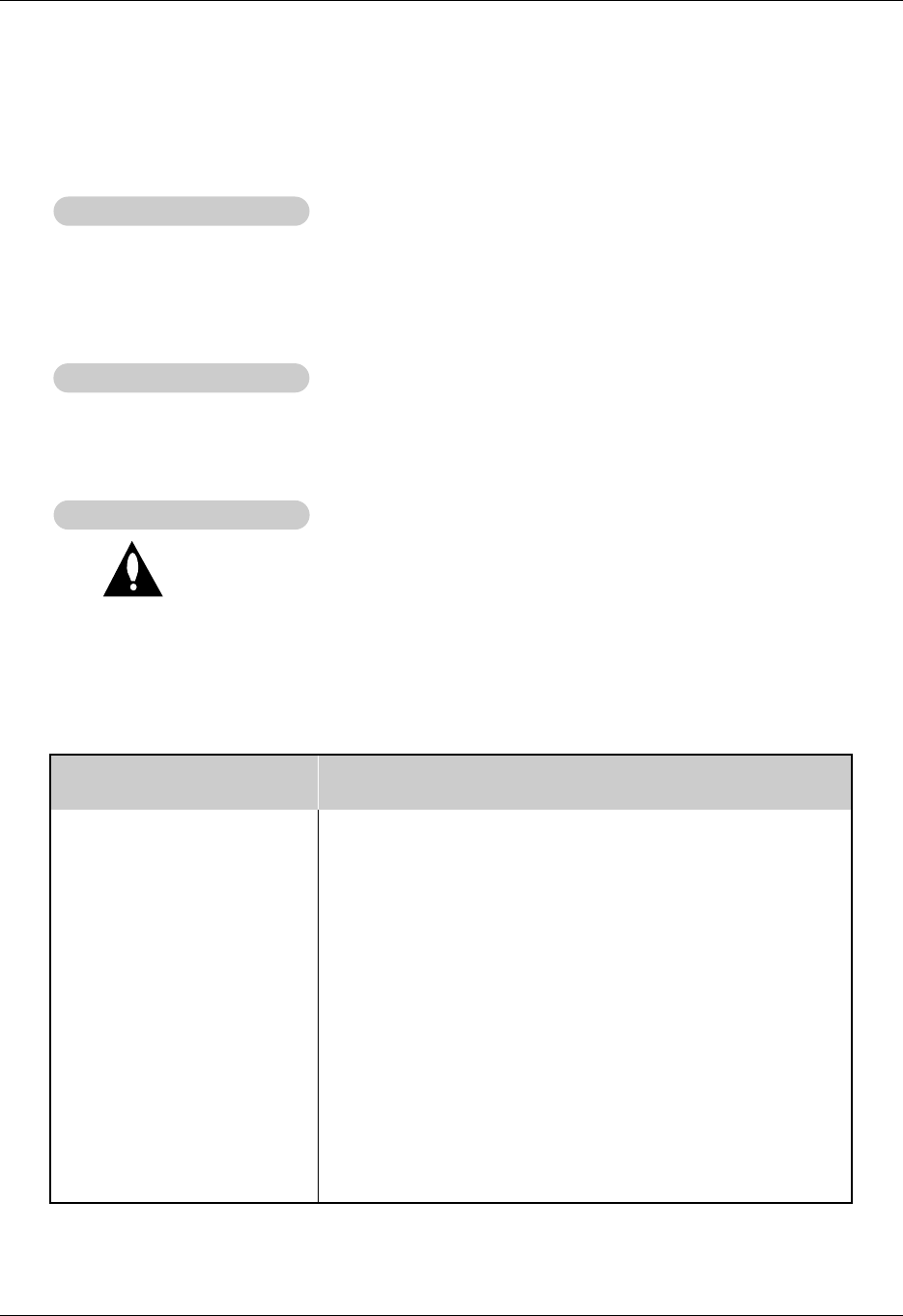
Owner’s Manual 33
Maintenance & Specification
•The specifications shown above may be changed without notice for quality improvement.
1. Here’s a great way to keep the dust off your screen for a while. Wet a soft cloth in a mixture of lukewarm water and
a little fabric softener or dish washing detergent. Wring the cloth until it’s almost dry, and then use it to wipe the
screen.
2. Make sure the excess water is off the screen, and then let it air-dry before you turn on your Monitor.
To remove dirt or dust, wipe the cabinet with a soft, dry, lint-free cloth.
Please be sure not to use a wet cloth.
If you leave your Monitor dormant for a long time (such as a vacation), it’s a good idea to unplug the
power cord to protect against possible damage from lightning or power surges.
- Early malfunctions can be prevented. Careful and regular cleaning can extend the amount of time you will have your
new Monitor. Be sure to turn the power off and unplug the power cord before you begin any cleaning.
Cleaning the Screen
Cleaning the Screen
Cleaning the Cabinet
Cleaning the Cabinet
Extended
Extended Absence
Absence
MODEL
Width (inches / mm)
Height (inches / mm)
Depth (inches / mm)
Weight (pounds / kg)
Power requirement
Resolution
Color
Operating Temperature Range
Operating Humidity Range
Maximum Elevation
MU-50PZ90M/90MA/90MB/90MK/90MR/90MS
MU-50PZ90V/90VA/90VB/90VK/90VR/90VS
48.2 / 1223
28.9 / 734
4.1 / 105
99.2 / 45
AC120V, 60Hz
1366 x 768 (Dot)
16,770,000 (256 steps of each R, G and B)
32 ~ 104°F (0 ~ 40°C)
Less than 80%
6561 feet (2000m)
Maintenance
Maintenance
Product Specifications
Product Specifications

PLASMA MONITOR
OWNER’S MANUAL
Please read this owner’s manual carefully before operating the
Monitor.
Retain it for future reference.
Record model number and serial number of the Monitor.
See the label attached on the back of the Monitor and quote
this information to your dealer when you require service.
Model number :
Serial number :
MODELS:MU-50PZ90M/90V
MU-50PZ90MA/90VA
MU-50PZ90MB/90VB
MU-50PZ90MK/90VK
MU-50PZ90MR/90VR
MU-50PZ90MS/90VS
P/NO : 3828VA0410A (RF03GB)